issue034 settembre2023

Magazine dedicated to textiles, from yarn to fabric, for furnishing and fashion industry

La rivista tecnica per il settore tessile dal filato al tessuto ISSN 2421-4779 textures www.servizi-e-seta.com Poste Italiane spaSped. Abb. Post.D.L. 353/2003 (Convertito in legge 27/02/2004 n. 46), art. 1, comma 1 LO/MI/ eur o 10,00 In caso di mancato recapito rinviare all’ufficio CMP Roserio (Mi) per la restituzione al mittente che si impegna a pa gare la relativa tariffaEditrice webandmagazine s.r.l.Via Valla, 16I-20141 Milanowww.webandmagazine.media

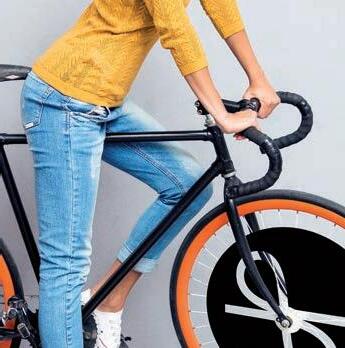



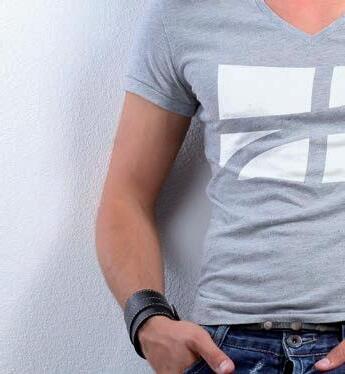



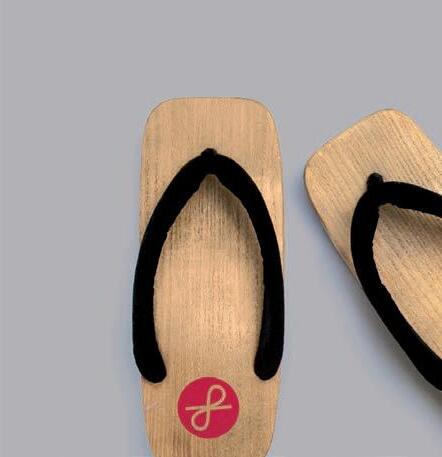







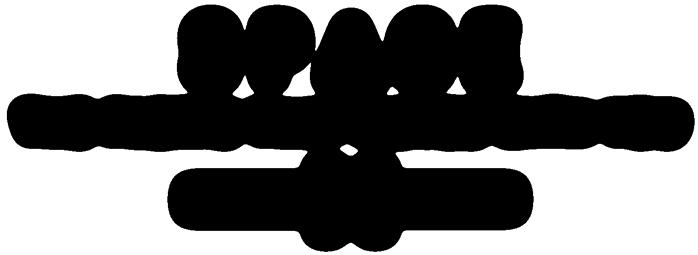


ISSUE34SETTEMBRE2023
editrice WEBANDMAGAZINE s.r.l. VIA VALLA, 16 - 20141 MILANO ITALIA
T. +39/02 84173130

T. +39/02 84173121 (MARKETING) @ amministrazione@webandmagazine.com www www.webandmagazine.media
DIRETTORE RESPONSABILE EDITOR IN CHIEF PIETRO FERRARI
REDAZIONE@WEBANDMAGAZINE.COM
DIRETTORE EDITORIALE EDITORIAL COORDINATOR



BEATRICE GUIDI
BEATRICEGUIDI_MKT@WEBANDMAGAZINE.MEDIA

GIORNALISTI
JOURNALISTS
SONIA MARITAN
COLLABORATORI COLLABORATORS
CAMILLA CARRARA, PAOLA GOVONI, MARIADELE MANCINI, STEFANO PANCONESI, RENATA POMPAS
WEB AND MEDIA ADVERTISING

BEATRICE GUIDI DIREZIONE MARKETING BEATRICEGUIDI_MKT@WEBANDMAGAZINE.MEDIA ADVERTISING@WEBANDMAGAZINE.COM MKT@WEBANDMAGAZINE.MEDIA
WEB AND SOCIAL MEDIA EDITOR


MONICA ZANI
MKT@WEBANDMAGAZINE.MEDIA
GRAPHIC LAYOUT UFFICIOGRAFICO@WEBANDMAGAZINE.COM
UFFICIO LOGISTICA LOGISTIC OFFICE
LOGISTICA@WEBANDMAGAZINE.COM
AMMINISTRAZIONE ADMINISTRATION
LAURA GREGORUTTI AMMINISTRAZIONE@WEBANDMAGAZINE.COM
RIVISTA TRIMESTRALE: POSTE ITALIANE SPA SPED. ABB. POST.D.L. 353/2003 (CONVERTITO IN LEGGE 27/02/2004 N.46), ART. 1, COMMA 1 - LO/MI
REGISTRO DEGLI OPERATORI
DI COMUNICAZIONE - ROC 23567
REGISTRO MONDIALE
DELLE PUBBLICAZIONI ISSN 2283-8651
RIVISTA TRIMESTRALE QUARTERLY MAGAZINE
UNA COPIA ONE COPY EURO 10,00
ABBONAMENTO ANNUO ITALIA EURO 30,00
A YEAR’S SUBSCRIPTION ABROAD EURO 60,00
MODALITÀ DI PAGAMENTO ABBONAMENTO
TRAMITE BONIFICO BANCARIO CON TUTTI I VOSTRI DATI E CAUSALE UTILIZZANDO IL SEGUENTE IBAN: CRÉDIT AGRICOLE: IT19K0623001619000040434367
I NOMI, LE DITTE E I PRODOTTI CITATI REDAZIONALMENTE SONO PUBBLICATI SENZA RESPONSABILITÀ DELL’EDITORE; TESTI E FOTOGRAFIE, ANCHE SE NON PUBBLICATI, NON VENGONO RESTITUITI NAMES, FIRMS AND PRODUCTS WICH ARE QUOTED EDITORIALLY ARE PUBLISHED WITHOUT PUBLISHER’S RESPONSABILITY; TEXTS AND PHOTOS, ALTOUGH UNPUBLISHED, ARE NOT RETURNED
INFORMATIVA EX D. LGS.196/03 – WEBANDMAGAZINE S.R.L., TITOLARE DEL TRATTAMENTO TRATTA I DATI PERSONALI LIBERAMENTE CONFERITI PER FORNIRE I SERVIZI INDICATI. PER I DIRITTI DI CUI ALL'ART. 7 DEL D. LGS N. 196/03 E PER L'ELENCO DI TUTTI I RESPONSABILI DEL TRATTAMENTO RIVOLGERSI AL RESPONSABILE DEL TRATTAMENTO, INFO@WEBANDMAGAZINE.COM.
I DATI POTRANNO ESSERE TRATTATI DA INCARICATI PREPOSTI AGLI ABBONAMENTI, AL MARKETING, ALL'AMMINISTRAZIONE E POTRANNO ESSERE COMUNICATI A SOCIETÀ ESTERNE PER LA SPEDIZIONE DEL PERIODICO E PER L'INVIO DI MATERIALE PROMOZIONALE.
IL RESPONSABILE DEL TRATTAMENTO DEI DATI RACCOLTI IN BANCHE DATI A USO REDAZIONALE È
IL DIRETTORE RESPONSABILE A CUI CI SI PUÒ RIVOLGERE, PER I DIRITTI PREVISTI DAL D. LGS. 196/03, PRESSO: EDITRICE WEBANDMAGAZINE S.R.L., VIA VALLA, 16 - MILANO.
issue034 textures 004
COLOPHON
–
Stampa AGP Aziende Grafiche Printing Via Milano, 3/5
20068 Peschiera Borromeo Milano
–
B.I.C. CRPPIT2P166
issue034 settembre2023 Magazine dedicated from yarn for furnishing and fashion industry La rivista tecnica per il settore tessile dal filato al tessuto
www.servizi-e-seta.com Poste Italiane Sped. Abb. Post. 353/2003 (Convertito legge 27/02/2004 46), comma LO/MI/ 10,00 caso mancato recapito rinviare all’ufficio CMP Roserio (Mi) per restituzione mittente impegna gare relativa tariffa Editrice webandmagazine Via Valla, I-20141 Milano www.webandmagazine.media COVER: Servizi e Seta s.r.l. www.servizi-e-seta.com
textures
FinoLino
Extrafine Linen Organic Cotton

www.monticolor.com
MONTICOLOR
09 EDITORIALE
IL FUTURO DELL’INDUSTRIA TESSILE THE FUTURE OF THE TEXTILE INDUSTRY
di Beatrice Guidi
10 COVERSTORY SERVIZI E SETA
AL PASSO COI TEMPI KEEPING UP WITH THE TIMES
di Pietro Ferrari
16 INCONTRI
MICHELLE MARZOLI FILMAR
UN APPROCCIO CONCRETO ALLA SOSTENIBILITÀ A COMPLETE APPROACH TO SUSTAINABILITY
di Pietro Ferrari
22 PERCORSITESSILI
FILIDARTE GROUP
CRESCE IL POLO DEI FILATI DI ETHICA GLOBAL INVESTMENTS FILIDARTE, ETHICA GLOBAL INVESTMENTS’ YARN HUB, IS GROWING
di Beatrice Guidi
24 PERCORSITESSILI
MILANO UNICA 24 ALBINI GROUP
25 CHARGEURS PCC 26 EUROJERSEY
E TINTORIA EMILIANA
26 BOTTO GIUSEPPE
27 TESSUTI DI SONDRIO (MARZOTTO GROUP)
a cura della Redazione
29 PERCORSITESSILI
FILI PARI
DAL MARMO AL TESSUTO
ALTERNATIVE SOLUTIONS FROM TWO MADE IN ITALY EXCELLENCES a cura della Redazione
32 EVENTI
NUMERI POSITIVI
DALLE MANIFESTAZIONI TESSILI
32 PITTI FILATI
33 PV PARIS
33 TEXWORLD PARIS
34 MILANO UNICA
34 FILO60 di Beatrice Guidi
36 SPAZIOGREEN
BESTE
DA TEMPI NON SOSPETTI....
SINCE UNSUSPECTING TIMES.... di Pietro Ferrari
40 SPAZIOGREEN
FSC® FOREST
STEWARDSHIP COUNCIL
IL PATTO DELL'INDUSTRIA DEL FASHION PER PROTEGGERE LE FORESTE DEL MONDO FASHION INDUSTRY’S PACT TO PROTECT THE WORLD'S FORESTS di FSC®
48 ART AND TEXTILE TRANSITIONS. CONTAMINAZIONE VIRTUOSA FRA ARTE E MODA A FIRENZE TRANSITIONS. VIRTUOUS CONTAMINATION BETWEEN ART AND FASHION IN FLORENCE di Paola Govoni
54 AREAARREDAMENTO
TOLLEGNO 1900
LA LANA VESTE L’INTERIOR WOOL DRESSES THE INTERIOR di Beatrice Guidi
56 AREAMAGLIERIA
MIC MANIFATTURA
ITALIANA CUCIRINI
MILLE VARIANTI E MILLE COLORI
THE CREATIVE AND TECHNOLOGICAL COLLABORATION BETWEEN MIC MANIFATTURA ITALIANA CUCIRINI AND SHIMA SEIKI CONTINUES di Pietro Ferrari
t e x turess
61 AREA
TESSUTO TECNICO
PRIMALOFT





SUCCESSO IMMEDIATO PER ACTIVE EVOLVE THE EXPANSION OF THE PRIMALOFT ACTIVE RANGE IS ENHANCED BY NEW PROPOSALS a cura della Redazione
64 AREA
TESSUTO TECNICO
68 AREATECNOLOGIE
EFITM REGGIANI
STAMPA TESSILE DIGITALE: NUOVE CAPACITÀ PRODUTTIVE
DIGITAL TEXTILE PRINTING: NEW PRODUCTION CAPABILITIES di Beatrice Guidi
72 COLOURS
ATLANTE DEL NON COLORE: LE FIBRE ANIMALI
TECHNOW
TECHNOW: OLTRE LA FORNITURA DEL TESSUTO TECNICO
TECHNOW: BEYOND THE SUPPLY OF TECHNICAL FABRIC di Beatrice Guidi

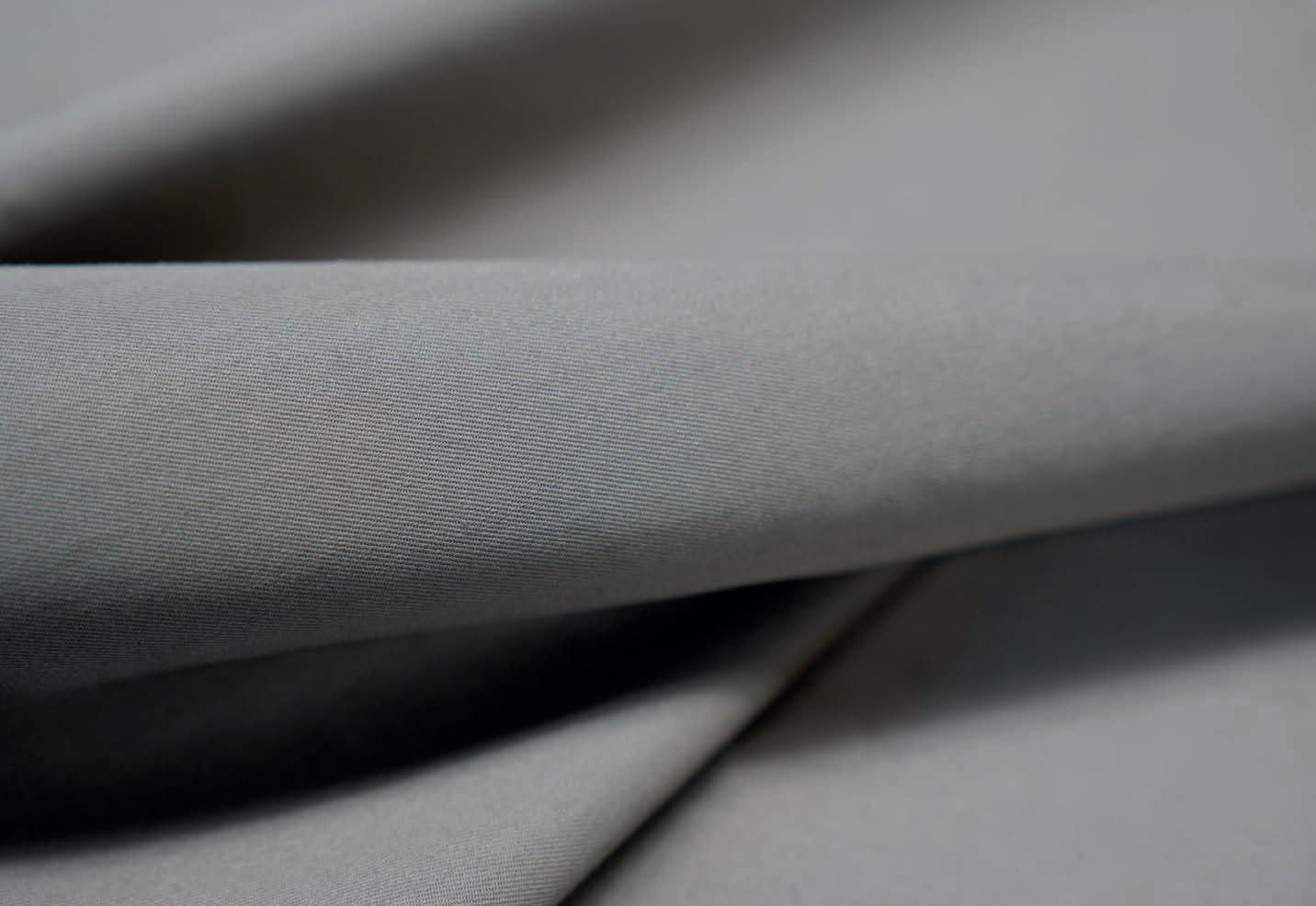
ATLAS OF NON-COLOR: ANIMAL FIBERS di Stefano Panconesi
turessommario
DAL FIOCCO AL CAPO FINITO
DEPSUM Articolo: 65% cotone 35% seta beste.com 138 cm 250 gr/mtl 181 gr/mtq
t e
 writer Beatrice Guidi
writer Beatrice Guidi

IL FUTURO DELL’INDUSTRIA TESSILE
Le mosse delle aziende nel settore tessile si dirigono sempre più verso un modello di business, in cui la sostenibilità ambientale è al primo posto. Abbiamo incontrato e intervistato imprenditori e in questo numero racconteremo come le aziende del settore moda stanno affrontando le sfide che questa transizione sostenibile impone e come le diverse visioni strategiche siano tutte rivolte all’ottimizzazione produttiva per un minor impatto sull’ambiente.
Il primo appuntamento ci vedrà a Filo a Milano, che celebra la sua 60a edizione e continua la sua crescita sia in termini di spazio espositivo, sia di numero degli espositori, mettendo al centro il tema della sostenibilità.
Tra gli eventi autunnali anche
il jeans diventa protagonista, con le giornate di Genova Jeans di ottobre e quelle di Milano con Denim PV a novembre.
Genova è la culla del jeans e si farà portavoce di nuovi valori quali creatività, tecnologia e produzione responsabile nel rispetto dell’heritage culturale, profondamente intrecciato con la città in cui tutto ebbe inizio: Janne, il nome di Genova in francese antico secondo il dizionario Oxford, è dove è stato prodotto il cotone pesante oggi utilizzato per i jeans. I genovesi sono stati i primi ad avere l’idea di tingere di blu indaco un fustagno prodotto nella città ligure. Da tessuto da lavoro utilizzato nei porti, il jeans è diventato un capo di abbigliamento iconico che annulla le differenze
THE FUTURE OF THE TEXTILE INDUSTRY
The steps of companies in the textile industry are increasingly directed toward a business model, in which environmental sustainability is at the forefront. We have met and interviewed businessmen, and in this issue we will report on how companies in the fashion industry are facing the challenges that this sustainable transition imposes and how different strategic visions are all aimed at production optimization for less impact on the environment.
The first event will see us at Filo in Milan, which celebrates its 60th edition and continues its growth both in terms of exhibition space and number of exhibitors, putting the theme of sustainability at the center.
Among the fall events, denim also takes center stage, with Genova Jeans days in October and Milan's Denim PV in November.
generazionali, sociali, stagionali e culturali ed è presente nel guardaroba di tutti, negli stili di vita e nell’immaginario collettivo.
Genoa is the cradle of jeans and will be a spokesperson for new values such as creativity, technology and responsible production while respecting its cultural heritage, deeply intertwined with the city where it all began: Janne, the name of Genoa in Old French according to the Oxford dictionary, is where the heavy cotton used today for jeans was produced. The Genoese were the first to come up with the idea of dyeing a fustian produced in the Ligurian city in indigo blue.
From a work fabric used in ports, denim has become an iconic garment that cancels generational, social, seasonal and cultural differences and is present in everyone's wardrobe, lifestyles and collective imagination.
textures 09 issue034
EDITORIALE
writer Pietro Ferrari www.servizi-e-seta.com
AL PASSO COI TEMPI
Abbiamo avuto l’opportunità di incontrare in diverse occasioni Alberto Enoch e di discutere della situazione del mercato che negli ultimi anni non ha certo risparmiato colpi di scena e forti emozioni. È ora il momento di dare uno sguardo da vicino a una realtà come Servizi e Seta, sempre più protagonista nel settore tessile.
Servizi e Seta, nata nel giugno 2008 da G. Schneider Group e Alberto Enoch, è specializzata nella produzione e trading di filati in cento per cento seta e misti seta con fibre nobili, filati in puro lino e misto lino con fibre naturali, e filati sempre in pura lana e misti con filati con procedimento semi-cardato Superfine. Grazie alla sua presenza diretta in Cina, con una struttura dedicata nata a seguito della joint-venture in quel Paese, agli uffici esecutivi con sede a New York, Tokyo, Hong Kong e Zhangjiagang e al costante controllo delle materie prime, Servizi e Seta è in grado di garantire ai suoi clienti i più alti standard qualitativi e una veloce risposta ai cambiamenti del mercato.
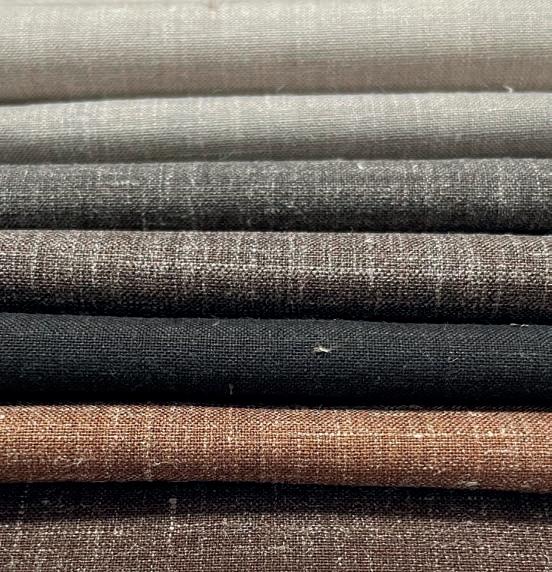
PIETRO FERRARI – Dal 2018 al 2022, Servizi e Seta ha conosciuto un raddoppio del fatturato, eppure non sono stati anni facili, quali strategie ha adottato per "crescere nella tempesta"?

ALBERTO ENOCH – Il fatturato è raddoppiato dal 2018 al 2022 e anche il 2023 segna ancora un ulteriore crescita, confermando che la visione aziendale è in linea con gli obiettivi. La società sviluppa i suoi prodotti nei diversi settori tessili: dalla tessitura, al jersey alla maglieria con una percentuale di fatturato in equilibrio nei tre ambiti. Il prodotto distribuito su più mercati e in diverse aree geografiche si presenta non solo come stagionale, ma con una vita media di circa 4/5 anni.
La fantasia è sempre presente, ma mai eccessiva e molto equilibrata nei colori e negli effetti.
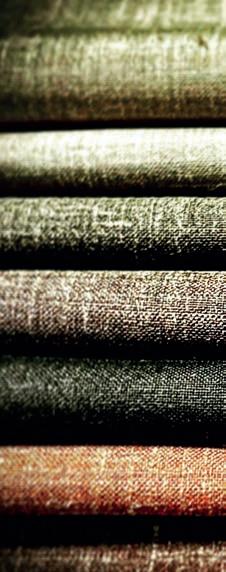
issue034
textures 10 COVERSTORYSERVIZI E SETA
SERVIZI E SETA TRACCIA IL SENTIERO TRA LA CAPACITÀ TECNOLOGICA E
PRODUTTIVA
INTERNA E IL CORRETTO UTILIZZO DI RISORSE PRODUTTIVE ESTERNE.
Nella foto, Alberto Enoch, Amministratore Delegato di Servizi e Seta.
La nuova collezione filati PE25 di Servizi e Seta a Filo, Milano.
Servizi e Seta partecipa a FILO il 20-21 settembre a MiCo Milano Convention Centre, con i nuovi filati certificati ai quali si aggiunge, per la prima volta sul mercato liniero, il lino 100% certificato GRS e presenta una collezione per l’estate 2025 scandita da filati con una dominante comune, l’effetto crepe.
Servizi e Seta participates in FILO on September 20-21 at MiCo Milano Convention Centre, with new certified yarns to which 100% GRS-certified linen is added for the first time on the linen market, and presents a collection for summer 2025 punctuated by yarns with a common dominant, the crepe effect.
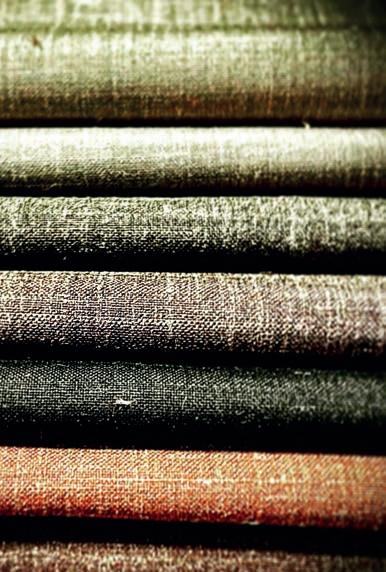


Il prodotto è e rimane la caratteristica che denota Servizi e Seta e il servizio, nomen omen, è il valore aggiunto. Infatti, oggi il successo di un filato è il corretto mix tra prodotto, colore e servizio.
PIETRO FERRARI – La fase attuale che vede un ritorno di attività produttive in Italia e investimenti in personale e tecnologie sul territorio nazionale significa una crisi del modello della delocalizzazione o la constatazione che determinate lavorazioni e competenze non sono esportabili?
ALBERTO ENOCH – La delo-
calizzazione non va demonizzata, ormai alcune produzioni non possono più essere effettuate sul territorio italiano.
L’outsourcing richiede comunque molta attenzione, infatti è importante valutare a priori quelli che sono i vantaggi, i fornitori e il luogo di provenienza delle materie prime. Servizi e Seta oggi ha in corso un grande investimento in nuovi impianti produttivi che le danno la possibilità di garantire un migliore controllo su tutta la filiera, migliorando così la qualità e il servizio al cliente, aggiungendo quel valore tipico del settore manifat-
turiero. Il mercato richiede sempre più la tracciabilità dalla materia prima al prodotto finito, e solo un processo produttivo interno può garantire la giusta sostenibilità ambientale, sociale ed economica dando maggiori garanzie al personale impiegato, oltre ad un corretto controllo qualitativo e una velocità di servizio. Il controllo di filiera con tutte le sue fasi di lavorazione permette di garantire non solo una qualità eccellente ma anche tutti gli aspetti "virtuosi" coinvolti nella produzione industriale.
textures 11
PIETRO FERRARI – L'enfasi posta sulle operazioni di ritorcitura è principalmente voluta per una maggior autonomia produttiva o risponde a esigenze di mercato crescente?
ALBERTO ENOCH – La ritorcitura per un’azienda tessile è il cuore della creatività, le richieste di questi ultimi anni ci hanno portato ad un sempre maggiore utilizzo di filati innovativi costruiti e assemblati da sapienti professionalità. Una creatività che trova la sua culla naturale in Italia dove i tecnici specializzati e le tecnologie più avanzate garantiscono risultati e qualità insuperabili. Le aziende oggi sono per lo più portate ad investire su prodotti fantasia che lasciano spazio a maggiori marginalità ed inoltre le piccole produzioni non sono aggredibili da parte di grandi produttori, rendendosi cosi autonome dai mercati del Far East.
Da parte nostra stiamo affrontando un nuovo importante investimento che va in questa direzione, oltre alla ricerca della qualità e di un migliore servizio, si aggiunge la possibilità di innovare processi e prodotti che non siano facilmente copiabili. Una produzione interna fornisce maggiori garanzie di successo e riservatezza.
PIETRO FERRARI – Oggi più che mai la R&S è una fase fondamentale dell'attività aziendale, in quale direzione, in generale, orienterete questa ricerca?
ALBERTO ENOCH – Proprio in questa ottica gli investimenti saranno più cospicui nel settore della Ricerca e Sviluppo, con la creazione di un


issue034 www.servizi-e-seta.com textures 12
COVERSTORYSERVIZI E SETA
reparto ad hoc, con macchinari costruiti e modificati in azienda che possano garantire la realizzazione di prodotti innovativi, non solo
sulla base di un corretto uso dei filati e colori diversi, ma anche con processi che garantiscano una vita più lunga e più remunerativa ai filati di nuova concezione.
La ricerca e la produzione interna per Servizi e Seta saranno una garanzia di
KEEPING UP WITH THE TIMES
We had the opportunity to meet Alberto Enoch on several occasions and to discuss the market situation which has certainly not spared twists and strong emotions in recent years.
Now is the time to take a closer look at a company like Servizi e Seta, more and more a protagonist in the textile sector.


Servizi e Seta, founded in June 2008 by G. Schneider Group and Alberto Enoch, is specialized in the production and trading of yarns in one hundred percent silk and mixed silk with noble fibres, yarns in pure linen and mixed linen with natural fibres, and always in pure wool and mixed with Superfine semicarded yarns.
Thanks to its direct presence in China, with a dedicated structure created following the joint venture in that country, to the executive offices based in New York, Tokyo, Hong Kong and Zhangjiagang and to the constant control of raw materials, Servizi e Seta is able to guarantee its customers the highest quality standards and a quick response to market changes
PIETRO FERRARI – From 2018 to 2022, Servizi e Seta experienced a doubling of its turnover, yet they were not easy years, what strategies did you adopt to "grow in the storm"?
ALBERTO ENOCH –The turnover doubled from 2018 to 2022 and 2023 also marks further growth, confirming that the company vision is in line with the objectives. The company develops its products in the various textile sectors: from weaving to jersey to knitwear with a balanced percentage of turnover in the three areas.
The product distributed on multiple markets
sviluppo e di continuità di tutte quelle attività che porteranno benefici sia di natura economica che di diversificazione di prodotto, per promuoverla come Azienda innovativa proiettata verso un servizio di qualità a tutto tondo per il proprio cliente.
english text
textures 13
and in different geographical areas is presented not only as seasonal, but with an average life of approximately 4/5 years. Fantasy is always present, but never excessive and very balanced in colors and effects. The product is and remains the characteristic that denotes Servizi e Seta and the service, nomen omen, is the added value. In fact, today the success of a yarn is the correct mix of product, color and service.
PIETRO FERRARI – Does the current phase which sees a return of production activities in Italy and investments in personnel and technologies on the national territory mean a crisis of the delocalisation model or the observation that certain processes and skills are not exportable?
ALBERTO ENOCH – Delocalization should not be demonized, some productions can no longer be carried out on Italian territory. However, outsourcing requires a lot of attention, in fact it is important to evaluate beforehand what the advantages are, the suppliers and the place of origin of the raw materials.
Servizi e Seta today has a large investment underway in new production plants which give it the possibility of guaranteeing better control over the entire supply chain, thus
improving quality and customer service, adding that value typical of the manufacturing sector.
The market increasingly requires traceability from the raw material to the finished product, and only an internal production process can guarantee the right environmental, social and economic sustainability, giving greater guarantees to the staff employed, as well as correct quality control and speed of service. The control of the supply chain with all its processing phases allows us to guarantee not only excellent quality but also all the "virtuous" aspects involved in industrial production
PIETRO FERRARI – Is the emphasis placed on twisting operations mainly intended for greater production autonomy or does it respond to growing market needs?
ALBERTO ENOCH –Twisting for a textile company is the heart of creativity, the demands of recent years have led us to an ever-increasing use of innovative yarns constructed and assembled by expert professionals. A creativity that finds its natural cradle in Italy where specialized technicians and the most advanced technologies guarantee unsurpassed results and quality.


Companies today are mostly led to invest in fancy products which leave room for greater margins and furthermore small productions cannot be attacked by large producers, thus making themselves independent from the Far East markets.
For our part, we are facing a new important investment that goes in this direction, in addition to the search for quality and better service, we add the possibility of innovating processes and products that are not easily copyable. Internal production provides greater guarantees of success and confidentiality.
PIETRO FERRARI – Today more than ever, R&D is a fundamental phase of company activity. In what direction, in general, will you direct this research?
ALBERTO ENOCH –Precisely from this perspective, investments will be more conspicuous in the Research and Development sector, with the creation of an ad hoc department, with machinery built and modified in the company that can guarantee the creation of innovative products, not only on the basis of a correct use of yarns and different colours, but also with processes that guarantee a longer and more profitable life for newly developed yarns. Internal research and production for Servizi e Seta will be a guarantee of development and continuity of all those activities that will bring benefits of both an economic nature and product diversification, to promote it as an innovative company projected towards an all-round quality service for your customer.
issue034 www.servizi-e-seta.com textures 14 COVERSTORYSERVIZI E SETA


22 & 23 November 2023 - Superstudio Più, Milan
©Anna Galaganenko
UN APPROCCIO CONCRETO ALLA SOSTENIBILITÀ
condo stringenti criteri di sostenibilità e adottando processi industriali che risparmiano acqua ed energia, controllando le sostanze chimiche utilizzate;
• Un prodotto realizzato da persone equamente retribuite e rispettate, persone alle quali è offerta la possibilità di miglioramento continuo per sviluppare conoscenze e abilità;
Filmar si è presentata all'ultima edizione di Pitti Filati (giugno 2023) con un approccio alla sostenibilità ancora più circonstanziato e concreto in piena coerenza con la filosofia aziendale. È stata l'occasione per fare il punto della situazione con Michelle Marzoli, marketing e communication manager dell'azienda.
PIETRO FERRARI – Cos'è il tessile sostenibile secondo Filmar?
MICHELLE MARZOLI – Cosa rende un filato sostenibile? In Filmar, ci poniamo questa domanda ormai da tanti anni.
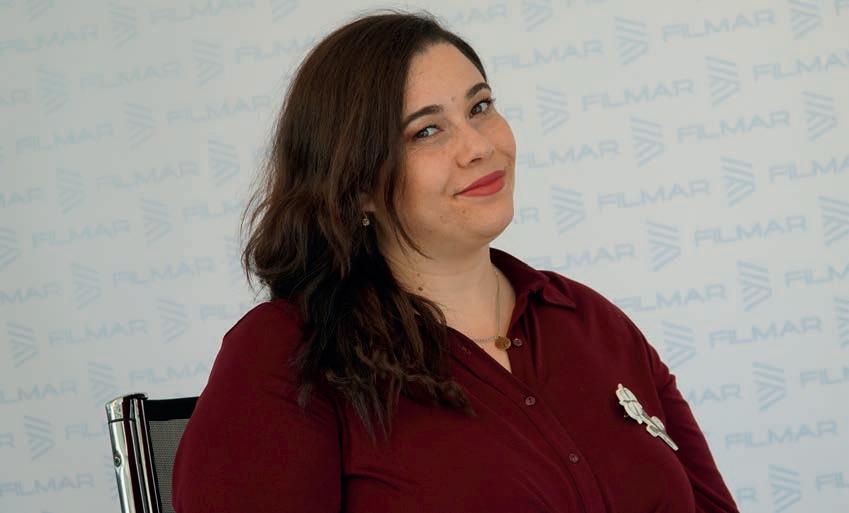
Fin dalla nostra fondazione nel 1958, ci siamo messi continuamente in gioco chiedendoci come possiamo aumentare la sostenibilità dei nostri filati per lasciare alle nuove generazioni una moda più responsabile. La sostenibilità è un valore fondamentale per Filmar, e per questo da anni ci impegniamo a ridurre gli impatti della produzione sulle persone e sull'ambiente. Secondo il nostro punto di vista, un filato sostenibile è:
• Un prodotto di qualità e durevole, realizzato utilizzando materie prime selezionate se-
• Un prodotto che migliora la crescita economica condivisa, in grado di garantire che il successo della nostra azienda agevoli anche il progresso sociale delle comunità che ci ospitano;
• Un prodotto tracciabile e trasparente che può vantare qualità e caratteristiche provate da certificazioni e documentazioni.
Per garantire quindi che i nostri filati soddisfino per quanto possibile queste caratteristiche, abbiamo definito diverse strategie.
A partire dalla nostra filiera produttiva, con cui lavoriamo in un’ottica di business inclusivo. In questo modo cerchiamo di garantire benefici e ritorni condivisi per il pianeta e per tutti gli stakeholder della
issue034 writer
www.
www.thecottonmuseum.com/it textures 16 INCONTRIMICHELLE MARZOLI FILMAR FILMAR AFFINA E APPROFONDISCE COSTANTEMENTE IL PROPRIO IMPEGNO NELLA SOSTENIBILITÀ CON L'INTRODUZIONE DEL DIGITAL PRODUCT PASSPORT.
Pietro Ferrari
filmar.it
Michelle Marzoli, marketing e communication manager di Filmar.
Digitalizzare la sostenibilità.
filiera tessile e della moda. Inoltre abbiamo deciso di investire nella tracciabilità e nella trasparenza dei nostri processi produttivi, monitorando le nostre filiere di approvvigionamento e assicurandoci che i nostri fornitori rispettino i nostri standard di qualità e di etica. Infine, pensiamo che la certificazione di processi e prodotti sia ormai un punto di partenza, non di arrivo.


Crediamo che oggi la sostenibilità si possa raggiungere solo partecipando direttamente a progetti ed attività per promuovere pratiche sostenibili di coltivazione e di trasformazione industriale del cotone. Per questo dal 2015 siamo attivi con il progetto Cottonforlife.
PIETRO FERRARI – Quali progressi nella filiera cotoniera in Egitto si sono resi possibili grazie a Cottoforlife?
MICHELLE MARZOLI – Cottonforlife nasce nel 2015 ed è un progetto innovativo di Corporate Social Responsibility focalizzato sulla filiera egiziana del cotone. Da sempre il cotone lega Filmar all'Egitto, in quanto l'Egitto è il produttore del migliore cotone al mondo. Le proprietà fisiche del cotone egiziano, quali lunghezza della fibra, micronaire e resistenza sono eccelse e ci hanno permesso nel tempo di distinguerci in termini di qualità dei nostri filati.
Da qui deriva la nostra devozione al cotone egiziano, alla sua storia, al suo presente e al suo futuro. Con un libro e un website, Filmar ha voluto disseminare la cultura e la storia del cotone egiziano. Un'opera fotografica e divulgativa insieme a strumenti didattici e artistici per coinvolgere e interessare un pubblico ampio e non solo specialistico.

textures 17
A COMPLETE APPROACH TO SUSTAINABILITY

Filmar was present at the latest edition of Pitti Filati (June 2023) with an even more detailed and concrete approach to sustainability in full coherence with the company philosophy. It was an opportunity to take stock of the situation with Michelle Marzoli, the company's marketing and communication manager
PIETRO FERRARI – What is sustainable fashion according to Filmar?

MICHELLE MARZOLI – What makes a yarn sustainable?
In Filmar, we have been asking ourselves this question for many years now. Since our foundation in 1958, we have continuously put ourselves on the line asking ourselves how we can increase the sustainability of our yarns to leave the new generations a more responsible fashion. Sustainability is a value essential for Filmar, and for this reason we have been committed to reducing impacts for years of production on people and the environment. According to our point of view, a sustainable yarn is:
• A quality and durable product, made using raw materials selected according to stringent sustainability criteria and adopting processes industries that save water and energy by controlling chemicals used.
• A product made by fairly paid and respected people, people to which the possibility of continuous improvement is offered to develop knowledge and skills.
• A product that improves shared economic growth, capable of guaranteeing that the success of our company also facilitates the social progress of host communities.
• A traceable and transparent product that boasts quality and characteristics proven by certifications and documentation.
To therefore ensure that our yarns meet these as far as possible characteristics, we have defined several strategies. Starting from our production chain, with which we work from a business point of view inclusive. In this way we try to guarantee shared benefits and returns for the planet and for all stakeholders in the textile and fashion supply chain. Also we have decided to invest in the traceability and transparency of our production processes, monitoring our supply chains and ensuring that our suppliers respect our quality and ethical standards. Finally, we think that the certification of processes and products is now a starting point, not an arrival point. We believe that today sustainability can only be achieved by participating directly to projects and activities to promote sustainable cultivation and production practices industrial processing of cotton. This is why we have been active with the project since 2015 Cottonforlife.
PIETRO FERRARI – What progress in the Egyptian cotton supply chain has been made possible thanks to Cottoforlife?
MICHELLE MARZOLI – Cottonforlife was born in 2015 and is an innovative Corporate Social Responsibility project focused on the Egyptian cotton supply chain. Cotton has always been a bond Filmar to Egypt, as Egypt is the producer of the best cotton in the world. The physical properties of Egyptian cotton, such as fiber length, micronaire and resistance are excellent and have allowed us over time to distinguish ourselves in terms of quality of our
issue034 www.filmar.it www.thecottonmuseum.com/it textures 18
english text INCONTRIMICHELLE MARZOLI FILMAR
Cottonforlife si inserisce in questo contesto ed ha un programma articolato per favorire la sostenibilità e l’inclusione di tutti gli stakeholder della filiera. Promosso dal gruppo Filmar Spa, realizzato da Filmar Nile Textile in coordinamento con UNIDO e con la partecipazione di ALEXBANK del Gruppo Intesa San Paolo, il progetto intende promuovere e sostenere una filiera tessile-cotoniera eco-compatibile e socialmente responsabile, contribuendo nel contempo a promuovere la moda sostenibile.

Cottonforlife lavora affinché la sostenibilità del cotone egiziano sia al centro delle strategie di Filmar e dei suoi clienti. Il cotone biologico e sostenibile diventa così materia prima esclusiva e preziosa, sia per gli effetti estetici e funzionali ad altissimo livello, sia per la crescita economica di individui e di famiglie. E da materia prima, il cotone diventa così anche elemento di coesione fra gli addetti alla filiera, strumento di conoscenza fra i contadini, gli operai italiani ed egiziani che, sia pure geograficamente distanti, si trovano uniti nell’affidare il futuro e il benessere delle proprie famiglie proprio al cotone.
PIETRO FERRARI – Come si esprime la collaborazione con Sustainable Brand Platform?
MICHELLE MARZOLI –Siamo consapevoli delle nuove sfide imposte dalla legislazione europea e mondiale, che richiede l'introduzione del passaporto digitale per i prodotti tessili, e ci siamo immediatamente attivati per essere al passo coi tempi. Il passaporto digitale è uno strumento innovativo che permette di
identificare il prodotto e di fornire informazioni sul suo ciclo di vita, dalla produzione alla distribuzione allo smaltimento. Questo sistema garantisce la sostenibilità ambientale e la trasparenza nella filiera tessile, così da consentirci di offrire ai nostri clienti e stakeholders la tracciabilità dei nostri prodotti. Poiché crediamo nel principio Lean secondo il quale si può migliorare solo ciò che si può misurare, un importante traguardo verso il raggiungimento di questo obiettivo è la misurazione del Life Cycle Assessment (LCA) delle nostre principali unità funzionali di cotone, disponibile pubblicamente tramite un semplice QR Code.
Il passaporto digitale è stato realizzato in collaborazione con Sustainable Brand Platform (SBP), startup italiana che ha sviluppato una piattaforma di sustainability intelligence per brand e aziende che operano nel settore della moda.
La piattaforma consente di monitorare, gestire e ottimizzare l’impatto ambientale aziendale, in termini di processi e prodotti finiti. Insieme a SBP abbiamo tracciato l’impatto ambientale dei nostri filati secondo i più moderni criteri: Global Warming Potential: la misurazione in kg CO2 equivalenti secondo le linee guida IPCC;
Water Use: la misurazione in metri cubi equivalenti secondo il metodo AWARE; Land Use: la misurazione in punti della qualità della terra utilizzata per la produzione dei filati secondo il metodo LANCA.
Queste misurazioni seguono le linee guida del più ampio framework PEF e sono disponibili online in modo che chiunque possa consultarli nella più ampia trasparenza.
Questo è solo un punto di partenza: vogliamo usare questi dati per migliorare di anno in anno il nostro impatto ambientale, integrando costantemente
textures 19
Le colture in Egitto, motivazione del personale.
Promuovere la digitalizzazione.
yarns. Hence our devotion to Egyptian cotton, its history, present and al its future. With a book and a website, Filmar wanted to disseminate culture and the history of Egyptian cotton. A photographic and informative work together with tools didactic and artistic to involve and interest a wide audience and beyond specialist.
Cottonforlife fits into this context and has an articulated program for promote the sustainability and inclusion of all stakeholders in the supply chain. Promoted by Filmar Spa group, created by Filmar Nile Textile in coordination with UNIDO e with the participation of ALEXBANK of the Intesa San Paolo Group, the project intends promote and support an eco-friendly and socially compatible textile-cotton supply chain responsible, while helping to promote sustainable fashion. Cottonforlife works to ensure that the sustainability of Egyptian cotton is at the heart of strategies of Filmar and its customers. Organic and sustainable cotton becomes like this exclusive and precious raw material, both for the very high aesthetic and functional effects level, both for the economic growth of individuals and families. And from raw material, the cotton thus also becomes an element of cohesion among those involved in the supply chain, an instrument of knowledge among peasants, Italian and Egyptian workers who, albeit geographically distant, they find themselves united in entrusting the future and well-being of their families just cotton.
PIETRO FERRARI – How is the collaboration with Sustainable Brand Platform expressed?
MICHELLE MARZOLI – We are aware of the new challenges imposed by European and global legislation, which requires the introduction of the digital passport for textile products, and we are here activated immediately to keep up with the times. The digital passport is one innovative tool that allows you to identify the product and provide information on its life cycle, from production to distribution to disposal.
This system guarantees environmental sustainability and transparency in the textile supply chain, thus to allow us to offer our customers and stakeholders the traceability of our products. Because we believe in the Lean principle that only this can be improved that can be measured, an important milestone towards achieving this objective is to measure the Life Cycle Assessment (LCA) of our main units functional cotton, publicly available via a simple QR Code. The digital passport was created in collaboration with Sustainable Brand Platform (SBP), an Italian startup that has developed a sustainability platform intelligence for brands and companies operating in the fashion sector. The platform allows you to monitor, manage and optimize the company's environmental impact, in terms of processes and finished products. Together with SBP we traced the impact environmental protection of our yarns according to the most modern criteria: Global Warming Potential: measurement
in kg CO2 equivalent according to the guidelines IPCC; Water Use: measurement in equivalent cubic meters according to the AWARE method; Land Use: The point measurement of the quality of land used for production of the yarns according to the LANCA method. These measurements follow the guidelines of the broader PEF framework and are available online so that anyone can consult them with the greatest transparency. This is just a starting point: we want to use this data to improve every year our environmental impact each year, constantly integrating the sustainability performance in our business strategies.
PIETRO FERRARI – What are the improvement projects for the future and in which direction.
MICHELLE MARZOLI – Filmar is planning a series of future improvement projects that aim to actively contribute to the achievement of global development goals sustainable. These projects focus on several key areas:
Traceability: Filmar intends to further improve the traceability of its products products, progressively extending the digital passport to all our units functional cotton.
The objective is to guarantee customers the origin and the sustainability of the materials used in production.
Energy Efciency: The company is working to further reduce consumption energy in production processes. We already have an important photovoltaic park on the roof, but over the next few years we will extend it further. This, together with interventions to increase the efficiency of machinery, will contribute to decrease the overall environmental impact of Filmar's operations.
Digitalisation: Filmar is investing in the digitalisation of its processes, including order management and communication with customers. We have recently released a new site that will progressively become a real and own B2B portal where our customers can consult all the information relating to our yarns and order them automatically.
Customer Service: this is one of our flagships, but we think it's not there should never be satisfied. Filmar is working to further improve the service to customers, making it faster, simpler and more transparent.
Customization: The company increasingly tries to satisfy the needs of customer customization. We can also flexibly produce batches of 1 kg and more we are doing more and more to keep up with an ever-growing market dynamic.
Waste Reduction: Filmar is committed to reducing waste in production and resource management. This will help minimize impacts environmental and optimize the use of resources.
Overall, Filmar is taking a comprehensive approach to sustainability, seeking constantly ways to improve its processes and products in line with its objectives global sustainable development.
These projects reflect the company's commitment to create a more sustainable and responsible future.
issue034 www.filmar.it www.thecottonmuseum.com/it textures 20 INCONTRIMICHELLE MARZOLI FILMAR
e ancora di più le performance di sostenibilità nelle nostre strategie aziendali.
PIETRO FERRARI – Quali sono i progetti di miglioramento per il futuro e in quale direzione?
MICHELLE MARZOLI – Filmar ha in programma una serie di progetti di miglioramento futuri che mirano a contribuire in modo attivo al raggiungimento degli obiettivi globali di sviluppo sostenibile.
Questi progetti si concentrano su diverse aree chiave:
Tracciabilità: Filmar intende migliorare ulteriormente la
tracciabilità dei propri prodotti, estendendo progressivamente il passaporto digitale a tutte le nostre unità funzionali di filato. L’obiettivo è quello di garantire ai clienti la provenienza e la sostenibilità dei materiali utilizzati nella produzione.
Efcienza Energetica: L'azienda sta lavorando per ridurre ulteriormente il consumo energetico nei processi di produzione. Già abbiamo un importante parco fotovoltaico sul tetto, ma nel corso dei prossimi anni lo estenderemo ulteriormente. Questo, insieme ad interventi per aumentare l’efficienza dei macchinari, contri
buirà a diminuire l'impatto ambientale complessivo delle operazioni di Filmar.
Digitalizzazione: Filmar sta investendo nella digitalizzazione dei propri processi, compresa la gestione degli ordini e la comunicazione con i clienti. Abbiamo recentemente rilasciato un nuovo sito che diventerà progressivamente un vero e proprio portale B2B dove i nostri clienti potranno consultare tutte le informazioni relative ai nostri filati e ordinarli automaticamente.
Servizio ai Clienti: questo è uno dei nostri fiori all’occhiello, ma pensiamo che non ci si debba mai accontentare. Filmar sta lavorando per migliorare ulteriormente il servizio ai clienti, rendendolo più veloce, semplice e trasparente.
Customizzazione : L'azienda cerca sempre più di soddisfare le esigenze di customizzazione dei clienti. Possiamo realizzare con flessibilità anche lotti da 1 kg e lo stiamo facendo sempre più per essere al passo con un mercato che è sempre più dinamico.

Riduzione degli Sprechi: Filmar è impegnata nella riduzione degli sprechi nella produzione e nella gestione delle risorse. Questo contribuirà a minimizzare gli impatti ambientali e a ottimizzare l'utilizzo delle risorse.
In generale, Filmar sta adottando un approccio completo alla sostenibilità, cercando costantemente modi per migliorare i propri processi e prodotti in linea con gli obiettivi globali di sviluppo sostenibile. Questi progetti riflettono l'impegno dell'azienda nel creare un futuro più sostenibile e responsabile.
textures 21
Colore e bellezza del cotone.
CRESCE IL POLO DEI FILATI DI ETHICA GLOBAL INVESTMENTS
Ethica Global Investments, società di investimento promossa da Ethica Group, comunica che la propria piattaforma dei filati italiani si arricchisce di un nuovo nome e una nuova identità: Filidarte Group, realtà che si propone come il polo di riferimento dei filati di eccellenza e del saper fare italiano al servizio della moda internazionale.
Obiettivo di Filidarte è la continua crescita finalizzata a rappresentare una proposta articolata e completa di eccel-
lenze nei filati di qualità Made in Italy, dal classico al fantasia, dal pettinato al cardato, indirizzata in particolar modo ai grandi brand internazionali della moda. In questo contesto aggregativo, la struttura organizzativa prevede che Filidarte abbia ruolo di implementa-

zione e coordinamento dell’indirizzo strategico delle proprie partecipate, promuovendo uno specifico modello di business che ha l’obiettivo di preservare e valorizzare identità, storia, clienti ed eccellenze delle singole società che lo compongono, supportandole per cogliere specifiche opportunità e per affrontare insieme le sfide del mercato. Al fine di accelerare il raggiungimento della massa critica necessaria per una massima valorizzazione del progetto, a

issue034 writer Beatrice Guidi https://filidartegroup.it - https://lanificiodellolivo.com - www.manifatturasesia.it textures 22
Filati di Manifattura Sesia
IL POLO DEI FILATI DI ETHICA GLOBAL INVESTMENTS SI ARRICCHISCE DI UN NUOVO NOME E CONSOLIDA RISULTATI RECORD: NASCE FILIDARTE GROUP - SHAPING THE FUTURE OF ITALIAN YARN EXCELLENCES. PERCORSOTESSILIFILIDARTE GROUP
Ethica Group è una realtà indipendente specializzata nella realizzazione di operazioni di finanza straordinaria e nell’investimento diretto nel capitale di rischio di imprese italiane. Le attività del gruppo comprendono l’M&A Advisory, il Debt Advisory, l’ECM Advisory e l’Equity Investments. Ethica Group si avvale di team di professionisti con significativi track-record nelle proprie aree di competenza. Dal 2010 il gruppo ha completato con successo numerose operazioni in molteplici settori industriali, affiancando imprenditori, grandi gruppi internazionali e investitori istituzionali italiani ed esteri con una prospettiva di medio-lungo termine.
Ethica Group is an independent company specialized in closing corporate finance transactions and in direct investment in the risk capital of Italian companies. The group's activities include M&A Advisory, Debt Advisory, ECM Advisory and Equity Investments. Ethica Group employs teams of professionals with significant track records in their areas of expertise. Since 2010, the group has successfully completed numerous transactions in multiple industrial sectors, supporting entrepreneurs, large international groups and Italian and foreign institutional investors with a medium-long term perspective.
Manifattura Sesia e Lanificio dell’Olivo, oggi cuore pulsante del progetto Filidarte, sono previste aggiungersi entro la fine del 2023 ulteriori realtà chiave della filiera dei filati Made in Italy in ottica di creare un modello multi-specialist con una piena penetrazione del mercato di riferimento. Nel corso del 2022 il gruppo ha raggiunto
FILIDARTE, ETHICA GLOBAL INVESTMENTS’ YARN HUB, IS GROWING
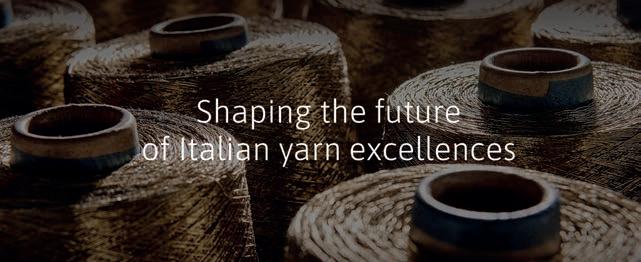
Ethica Global Investments, an investment company promoted by the Ethica Group, announces that its platform of Italian yarns is enriched with a new name and a new identity: Filidarte Group, a reality that presents itself as the reference pole for yarns of excellence and Italian know-how at the service of international fashion.
The objective of Filidarte is continuous growth aimed at representing a comprehensive and comprehensive range of excellence in Made in Italy quality yarns, from classic to

la soglia dei 45 milioni di euro di fatturato, con risultati economici di rilievo che negli anni a venire beneficeranno ulteriormente delle maggiori economie di scala e scopo. Oltre la metà delle vendite, suddivise in 92% maglieria e 8% aguglieria, è generato all’estero, principalmente in Francia e Nord America.
patterned, from worsted to carded, aimed in particular at the major international fashion brands.
In this aggregative context, the organizational structure envisages that Filidarte has the role of implementing and coordinating the strategic direction of its subsidiaries, promoting a specific business model that has the objective of preserving and enhancing the identity, history, customers and excellence of the individual companies that make it up, supporting them to seize specific opportunities and to face market challenges together.
In order to accelerate the achievement of the critical mass necessary for maximum valorisation of the project, Manifattura Sesia and Lanificio dell'Olivo, today the beating heart of the Filidarte project, are expected to add further key players in the Made in Italy yarn supply chain by the end of 2023 with a view to creating a multi-specialist model with full penetration of the reference market. During 2022, the group reached the threshold of 45 million Euro in turnover, with significant economic results that will further benefit from greater economies of scale and scope in the years to come. More than half of the sales, divided into 92% knitwear and 8% knitwear, are generated abroad, mainly in France and North America.
textures 23
english text
Filato Orville di Lanificio dell’Olivo
writer Redazione www.albinigroup.com - https://chargeurs-pcc.com www.sensitivefabrics.it - www.bottogiuseppe.com
PILLOLE DA MILANO UNICA PILLS FROM
IL PRIMO COTONE BIOLOGICO, TRACCIABILE E RIGENERATIVO
sentata dalle 872 balle di cotone raccolto nel 2022, che verranno trasformate in filati e tessuti da parte di ICA Yarns e Cotonificio Albini Garantire il minor impatto ambientale possibile e allo stesso tempo rigenerare la fertilità del terreno, per proteggere e arricchire le risorse naturali è la nuova sfida per Albini Group e un obiettivo raggiungibile proprio grazie all’agricoltura rigenerativa, un metodo olistico che punta alla razionalizzazione delle risorse.
ALBINI GROUP prosegue la propria strada di innovazione e ricerca di materie prime e processi di produzione sempre più naturali e sostenibili.
Già dal 2020 BIOFUSION® di Albini Group, il primo cotone biologico e scientificamente tracciabile, tramite scienza forense, viene coltivato con sistemi di produzione certificata e con tecniche innovative a basso impatto ambientale.
A Milano Unica Albini Group presenta REGENERATIVE BIOFUSION®, il primo cotone Supima biologico, tracciabile e rigenerativo, coltivato con i loro partner in California. La rilevanza dell’impegno del Gruppo Albini nel progetto è rappre-

THE FIRST ORGANIC, TRACEABLE AND REGENERATIVE COTTON
ALBINI GROUP continues its path of innovation and research into increasingly natural and sustainable raw materials and production processes.
In 2020, Albini Group's BIOFU-
SION®, the first organic and scientifically traceable cotton through forensic science, is already being grown with certified production systems and innovative techniques with low environmental impact.

issue034
textures 24 PERCORSITESSILIMILANO UNICA
At Milano Unica Albini Group presents REGENERATIVE BIOFUSION®, the first organic, traceable and regenerative Supima cotton grown with their partners in California. The significance of Albini Group's commitment

to the project is the 872 bales of cotton collected in 2022, which will be processed into yarns and fabrics by ICA Yarns and Cotonificio Albini. Ensuring the lowest possible environmental impact while regenerating soil
fertility to protect and enrich natural resources is the new challenge for Albini Group and a goal that can be achieved precisely through regenerative agriculture, a holistic method that aims to rationalize resources.
INCREASINGLY HIGH QUALITY INTERLINING
INTERFODERE DI QUALITÀ SEMPRE PIÙ ELEVATA
CHARGEURS PCC conferma il proprio impegno nel rispetto per l’ambiente, garantendo qualità sempre più elevata.
Dalla collaborazione tra la tecnologia Thindown, brevettata da NIPI, e NATIVA™, nasce la proposta Thindown+NATIVA™: completamente realizzata in Italia, questa linea di ovatte utilizza lana NATIVA™ abbinata alla eccezionale tecnologia Thindown, che ha rivoluzionato l’uso della
piuma, racchiudendo in un tessuto tutti i benefici della vera piuma, quali la leggerezza, il calore e la traspirabilità.
Thindown + NATIVA™ combina le performance più all’avanguardia: dal mantenimento della temperatura corporea ideale in qualunque condizione ambientale, all’approvvigionamento etico della lana e della piuma, fino alla naturale degradabilità del prodotto.
benefits of real down, such as lightness, warmth and breathability.

Thindown + NATIVA™ combines the most cutting-edge performance: from maintaining ideal body temperature in any environmental condition, to ethical sourcing of wool and down, to the natural degradability of the product.
CHARGEURS PCC confirms its commitment to respect for the environment, ensuring ever higher quality. From the collaboration between Thindown technology, patented by NIPI, and NATIVA™ , comes the Thindown+NATIVA™ proposal: completely made in Italy, this line of wadding uses NATIVA™ wool combined with the exceptional Thindown technology, which has revolutionized the use of down, encompassing in one fabric all the
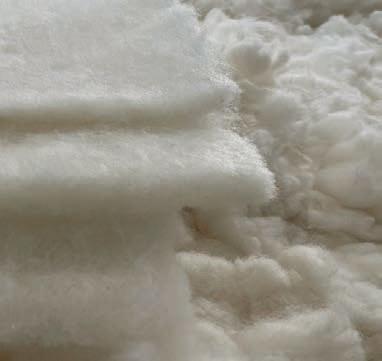
textures 25
www.albinigroup.com - https://chargeurs-pcc.com
www.sensitivefabrics.it - www.

EUROJERSEY e TINTORIA
EMILIANA presentano a Milano Unica una suggestiva “capsule” collection “MANHATTAN RELOADED”: outfit realizzati con i tessuti Sensitive® Fabrics di Eurojersey si trasformano grazie ai processi tintoriali di Tintoria Emiliana in un inno alla città
metropolitana con sfumature contemporanee.
Una nuova versione cromatica capace di nobilitare e conferire ad ogni capo della collezione un carattere distintivo, mantenendo le prestazioni uniche dei tessuti tecnici di Eurojersey.
FABRICS ARE TRANSFORMED
EUROJERSEY and TINTORIA
EMILIANA present at Milano Unica an evocative "capsule" collection "MANHATTAN RELOADED": outfits made with Eurojersey's Sensitive® Fabrics are transformed thanks to Tintoria Emiliana's dyeing processes into a
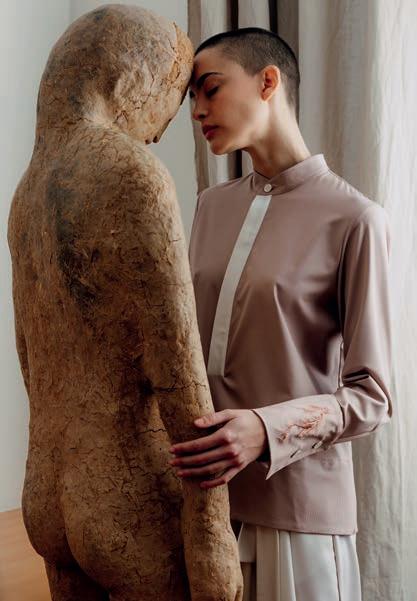

hymn to the metropolitan city with contemporary nuances. A new chromatic version capable of ennobling and giving each garment in the collection a distinctive character, while maintaining the unique performance of Eurojersey's technical fabrics.

I TESSUTI SI TRASFORMANO LA METAMORFOSI DI FIBRE NOBILI
BOTTO GIUSEPPE da sempre sensibile alle forme d’arte, ha deciso di sostenere il progetto Pravara della stilista Bav Tailor, paladina della moda consapevole, che ha ideato e realizzato 6 outfit della sua collezione autunno - inverno 2023/24 con i tessuti di cashmere, seta e lana Naturalis Fibra , condividendo la sua filosofia di attenzione all’aspetto più profondo del vivere, che riflette anche il loro concetto di moda sostenibile.
L’esclusivo tessuto SLOWOOLEARTH , interamente sostenibile e certificato RWS e CradletoCradleTM, è stato interpretato dalla stilista con un outfit composto da due pezzi, giacca (Lokya Lotus) e pantalone (Lokya Escape) .
issue034
textures 26 PERCORSITESSILIMILANO UNICA
bottogiuseppe.com
Forme ispirate dalla natura e ai saree indiani, volumi puri e silhouette dallo spirito libero raccontano la metamorfosi di fibre italiane naturali e nobili.
BOTTO GIUSEPPE, who has always been sensitive to art forms, decided to support the Pravara project of fashion designer Bav Tailor, a champion of conscious fashion, who designed and created 6 outfits from her fall - winter 2023/24 collection with Naturalis Fibra cashmere , silk
METAMORPHOSIS OF NOBLE FIBERS
and wool fabrics, sharing her philosophy of attention to the deepest aspect of living, which also reflects their concept of sustainable fashion. The exclusive SLOWOOLEARTH fabric, entirely sustainable and RWS and CradletoCradleTM certified, was interpreted by the designer with an
LA REINTERPRETAZIONE DI WORKWEAR E DENIM

In occasione della 37^ edizione di Milano Unica TESSUTI DI SONDRIO (MARZOTTO GROUP), propone tessuti innovativi sia dal punto di vista qualitativo che da quello creativo in cui cotone, lana, cachemire, alpaca, cammello e fibre vegetali dialogano per vestire la stagione autunno/inverno 2024/25.
Fil rouge: colori naturali, touch raffinato e ricerca estetico-tecnica capace di combinare heritage, innovazione e sostenibilita. Con il nuovo tessuto DRILL SONDRIO reinterpreta il tessuto per indumenti da lavoro in 100% cotone, dal mood contemporaneo, declinato nei colori-chiave cachi, verde e bluette.
outfit composed of two pieces , jacket (Lokya Lotus) and pants (Lokya Escape). Shapes inspired by nature and Indian sarees, pure volumes and free-spirited silhouettes tell the metamorphosis of natural and noble Italian fibers.
Con LUXURY DENIM, propone un look sportivo rivisitato in chiave piu ricercata, che vede protagonista la lana utilizzata in purezza o in mischia con cotone, cachemire o fibre vegetali come la canapa - che conferisce al tessuto proprieta antibatteriche – o come l’ortica, che imprime alle basi particolare compattezza e flessibilita.
THE REINTERPRETATION OF WORKWEAR AND DENIM
On the occasion of the 37th edition of Milano Unica TESSUTI DI SONDRIO (MARZOTTO GROUP), proposes innovative fabrics from both a qualitative and a creative point of view in which cotton, wool, cashmere, alpaca, camel and vegetable fibers dialogue to dress the fall/winter 2024/25 season. Fil rouge: natural colors, refined touch and aesthetic-technical research capable of combining heritage, innovation and sustainability.
With the new fabric DRILL SONDRIO reinvents the 100% cotton workwear fabric with a contemporary

mood, declined in the key-colors khaki, green and bluette.
With LUXURY DENIM, Tessuti di Sondrio proposes a sporty look revisited in a more refined key, featuring wool used in purity or blended with cotton, cashmere or vegetable fibers such as hemp-which gives the fabric antibacterial properties-or nettle, which imparts special compactness and flexibility to the bases.
textures 27


DAL MARMO AL TESSUTO
Fili Pari s.r.l. Società Benefit è una Startup innovativa Fashion-Tech che si pone l’obiettivo di portare l’innovazione al servizio del mondo tessile. L’azienda progetta prodotti innovativi a partire da un elemento tipico del territorio italiano: il marmo.
Fili Pari nasce dalla volontà di fornire soluzioni alternative ai tradizionali prodotti sul mercato, unendo innovazione, sostenibilità e Made in Italy. La Startup è fortemente radicata nel territorio italiano e abbraccia i valori dell’economia circolare, combinando ricerca e innovazione per migliorare il benessere del pianeta e delle persone che lo abitano attraverso l’intero ciclo di vita del prodotto.
La Startup è stata fondata nel 2020 ed il nome Fili Pari rappresenta l’anagramma di Fripi e Ali, i soprannomi delle due fondatrici: un riferimento immediato al filo, al mondo tessile, alla visione d'insieme che caratterizza il marchio.
Fili Pari è la prima Startup al mondo ad aver introdotto il marmo nel settore tessile grazie all’innovativo materiale MARM\MORE®, una spalmatura su tessuto realizzata con vera polvere di marmo che lo rende impermeabile, antivento e resistente. MARM\MORE® utilizza le potenzialità della

pietra per donare effetti estetici unici derivati dalla tipologia di marmo selezionato ed è attualmente disponibile nei settori arredo, abbigliamento, accessorio e calzatura.
Il termine nasce da MARMOR, traduzione latina di marmo, ad indicare lo stretto legame tra il materiale ed il territorio italiano.
Il MORE a seguire indica come il marmo dia un valore aggiunto al materiale, donando un plus rispetto ai classici spalmati in PU. MORE segnala inoltre una nuova e diversa percezione del marmo stesso, che da pesante e statico diventa leggero e indossabile.
MARM\MORE® ha reso possi-
bile la creazione di una sinergia tra l’industria tessile e quella della pietra: due settori che non hanno mai comunicato reciprocamente. L'amore per il territorio si traduce nella volontà di dare un valore alle materie prime, utilizzando i prodotti ed i sottoprodotti delle industrie della pietra italiani, trasformandoli in opportunità nel pieno rispetto dell'economia circolare.
LA TECNOLOGIA MINERALDYE
L’impegno di Fili Pari nella valorizzazione delle materie prime trova una nuova forma attraverso l'innovativa tecnologia brevettata MINERALDYE, un processo di tintura su filati
textures 29 issue034 writer Redazione https://filipari.com - www.marmmorefabrics.com PERCORSITESSILIFILI PARI
ALTERNATIVE DA DUE ECCELLENZE
MADE IN ITALY.
SOLUZIONI
DEL
MARM\MORE®, un materiale tecnico innovativo.
a basso impatto idrico che utilizza la polvere del marmo e di minerali come pigmenti naturali.
MINERALDYE è una vera rivoluzione per il mondo del tessile che, abbracciando tradizione e novità, trasforma un pro-
cesso altamente inquinante rendendolo innovativo, naturale e sostenibile. Il marmo e i minerali, da sempre protagonisti della storia, cultura, architettura ed economia del nostro Paese come materia prima d’eccellenza, si trasformano in
tintura e materia prima per prodotti innovativi, in una perfetta sinergia tra tradizione e innovazione.

MINERALDYE è la tintura su filato che utilizza la preziosa polvere di minerali come pigmento di tintura ed abbatte drasticamente l’utilizzo di acqua durante il processo. Il desiderio di dare una forma ai materiali sviluppati si è concretizzato con Fili Pari Collection: una collezione d’abbigliamento dallo stile fresco e minimale caratterizzata da una forte cura del dettaglio sia tecnica che stilistica: linee pulite ed essenziali, tessuti ricercati e manifattura artigianale rendono ogni capo unico. Il materiale tecnico MARM\MORE® viene utilizzato in combinazione con morbide lane, nylon riciclati e certificati, in un gioco di texture che uniscono comfort, performance e morbidezza. Ogni capo è realizzato interamente in Italia ed esprime la passione per la ricerca e il saper fare artigianale tipico del Made in Italy.

issue034 https://filipari.com - www.marmmorefabrics.com textures 30 PERCORSITESSILIFILI PARI
La palette di MINERALDYE.
ALTERNATIVE SOLUTIONS FROM TWO MADE IN ITALY EXCELLENCES
Fili Pari s.r.l. Società Benefit is an innovative Fashion-Tech Startup that aims to bring innovation to the service of the textile world. The company designs innovative products starting from a typical element of the Italian territory: marble. Fili Pari was born from the desire to provide alternative solutions to traditional products on the market, combining innovation, sustainability and Made in Italy. The Startup is strongly rooted in the Italian territory and embraces the values of the circular economy, combining research and innovation to improve the well-being of the planet and of the people who inhabit it throughout the entire life cycle of the product. The Startup was founded in 2020 and the name Fili Pari represents the anagram of Fripi and Ali, the nicknames of the two founders: an immediate reference to the thread, to the textile world, to the overall vision that characterizes the brand.
Fili Pari is the first Startup in the world to have introduced marble in the textile sector thanks to to the innovative MARM\MORE® material, a coating on fabric made with real marble powder that makes it waterproof, windproof and resistant. MARM\MORE® uses the potential of stone to give unique aesthetic effects derived from the type of marble selected and is currently available in the furniture, clothing, accessory and footwear sectors. The term comes from MARMOR, Latin translation of marble, to indicate the close link between the material and the Italian territory. The MORE below indicates how marble gives added value to the material, giving it a plus compared to the classic PU coated ones. MORE also signals a new and different perception of marble itself, which from heavy and static becomes light and wearable. MARM\MORE® has made it possible to create a synergy
between the textile and stone industries: two sectors that have never communicated with each other.
The love for the territory translates into the desire to give value to raw materials, using the products and by-products of the Italian stone industries, transforming them into opportunities in full respect of the circular economy.

MINERALDYE TECHNOLOGY
Fili Pari's commitment to enhancing raw materials finds a new form through the innovative patented MINERALDYE technology, a low water impact yarn dyeing process that uses marble and mineral dust as natural pigments.
MINERALDYE is a real revolution for the world of textiles which, embracing tradition and innovation, transforms a highly polluting process making it innovative, natural and sustainable. Marble and minerals, which have always been protagonists of the history, culture, architecture and economy of our country as raw materials of excellence, are transformed into dyes and raw materials for innovative products, in a perfect synergy between tradition and innovation.
MINERALDYE is the yarn dyeing that uses the precious mineral powder as dyeing pigment and drastically reduces the use of water during the process. The desire to give a shape to the materials developed has materialized with Fili Pari Collection: a clothing collection with a fresh and minimal style characterized by a strong attention to both technical and stylistic detail: clean and essential lines, refined fabrics and craftsmanship make each unique garment. MARM\MORE® technical material is used in combination with soft wool, recycled and certified nylon, in a play of textures that combine comfort, performance and softness. Each garment is made entirely in Italy and expresses the passion for research and the typical Made in Italy craftsmanship.
textures 31
english text
writer Beatrice Guidi
https://filati.pittimmagine.com
www.premierevision.com
https://texworld-paris.fr.messefrankfurt.com/paris/en.html
www.milanounica.it/it
https://filo.it
NUMERI POSITIVI DALLE MANIFESTAZIONI TESSILI PITTI FILATI
Tre giorni intensi in cui gli uffici stile dei grandi nomi della moda e i migliori maglifici internazionali sono arrivati in Fortezza per scoprire i filati più creativi e la ricerca stilistica e tecnologia più avanzata.
The June edition of Pitti Filati numero 93 recorded excellent results, demonstrating the important role of the fair for the spinning industry.
La 93^ edizione di Pitti Filati dello scorso giugno ha registrato ottimi risultati, dimo-

strando il ruolo importante del salone per il settore della filatura.
Three intense days in which the style offices of the big names in fashion world and the best international knitters came to the Fortezza to discover the most creative yarns and the most advanced stylistic research and technology.
issue034
textures 32 EVENTI
PV PARIS
Première Vision Paris, che quest'anno festeggia il suo 50° anniversario, continua a svolgere un ruolo trainante e unificante.
Mostrando l'eccezionale creatività e l'incrollabile impegno dei suoi espositori, Première Vision Paris traccia un percorso per un settore in costante evoluzione che affronta importanti sfide ambientali, sociali e tecnologiche.
Première Vision Paris, which celebrates its 50th anniversary this year, continues to play a driving and unifying role. Showcasing the exceptional creativity and unwavering commitment of its exhibitors, Première Vision Paris charts a course for a constantly evolving industry that faces significant environmental, social and technological challenges.
TEXWORLD PARIS
Questa edizione, "più parigina che mai" – che segnava anche il 25° anniversario di Texworld – si è distinta per il suo design rinnovato e per la qualità dell'esperienza offerta ai visitatori: un nuovo spazio TClub ridisegnato per favorire gli scambi commerciali.

This edition, "more Parisian than ever" – also marked Texworld's 25th anniversary –was also noted for its renewed design and the quality of the experience offered to visitors: a new T- Club space redesigned to encourage business exchanges,
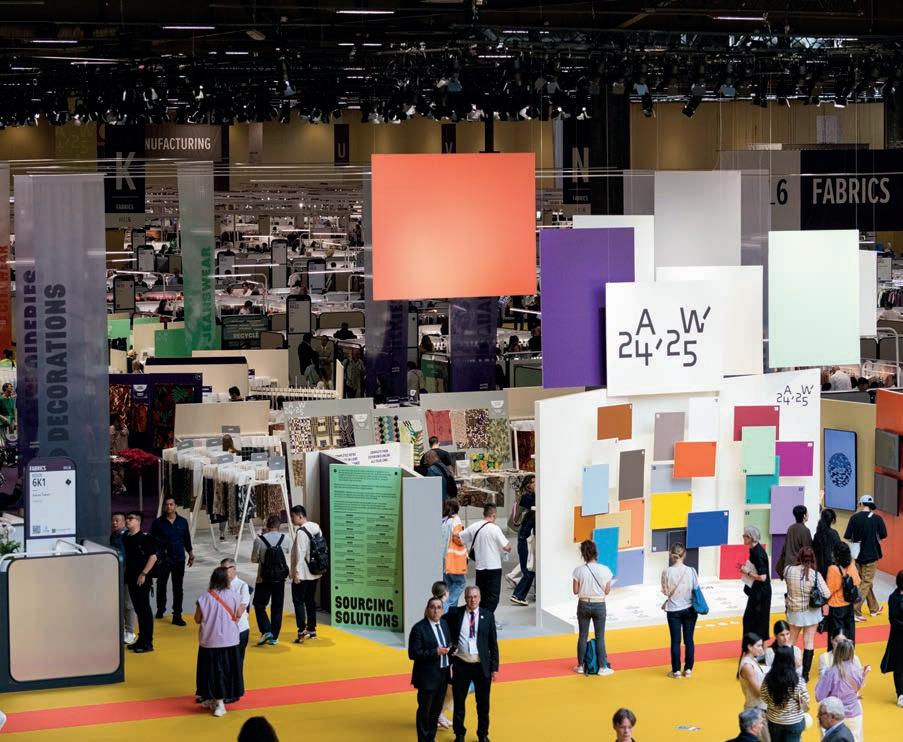
textures 33
Anche la 37^ edizione di Milano Unica si è chiusa con un segno positivo. Il successo è confermato dall’affluenza dei visitatori in crescita rispetto all’edizione di luglio 2022, ma anche dalla soddisfazione degli espositori, che hanno presentato collezioni di tessuti e accessori sempre più orientate verso

l’eleganza, la qualità e la sostenibilità creativa.
The 37th edition of Milano Unica also closed with a positive sign. The success is confirmed by the increased visitor turnout compared to the July 2022 edition, but also by the satisfaction of the exhibitors, who presented fabric and accessories collections increasingly oriented toward elegance, quality and creative sustainability.

MILANO UNICA FILO60
Nei suoi trent’anni di attività, Filo ha attraversato significative sfide e svolte di mercato, avendo come faro la qualità, la creatività e la collaborazione lungo la filiera, a cui si è aggiunta, nel corso degli anni, la sostenibilità. Sono gli stessi concetti che ritroviamo oggi nelle proposte delle aziende che partecipano al Salone e che disegnano il futuro del tessile.
Spiega Paolo Monfermoso, responsabile di Filo: “Il modo migliore di celebrare la 60a edizione di Filo e i trent’anni della sua attività è rendere il Salone ancora più efficace e più rispondente alle esigenze delle aziende che vi partecipano. Solo visitando Filo il 20 e 21 settembre visitatori e buyer potranno scoprire e per “toccare con mano” l’eccellenza dei
filati e dei materiali proposti dalle aziende espositrici e comprenderne a pieno i potenziali sviluppi tessili”.
In its 30 years of activity, Filo has gone through significant challenges and market turns, having quality, creativity and collaboration along the supply chain as its lighthouse, to which sustainability has been added over the years. These are the same concepts that we find today in the proposals of the companies participating in the Salone and designing the future of textiles.
Explains Paolo Monfermoso, head of Filo: "The best way to celebrate the 60th edition of Filo and its 30th anniversary is to make the Show even more effective and more responsive to the needs of the companies participating. Only by visiting Filo on September 20 and 21 will visitors and buyers be able to discover and to 'touch with their hands' the excellence of the yarns and materials offered by exhibiting companies and fully understand their potential textile developments”.
issue034 textures 34 EVENTI
dottor STEFANO PANCONESI


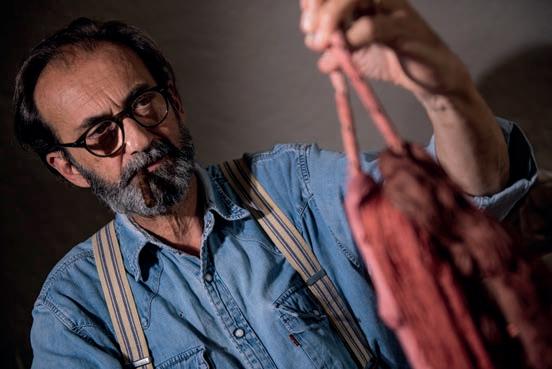
Via Italia, 6 - 13843 Pettinengo Biella Italia
T. +39/348 3326570
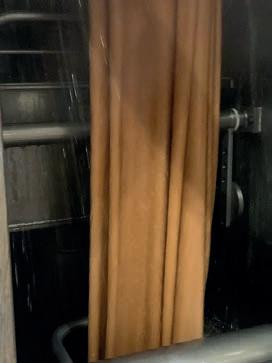

stefano.panconesi@gmail.com www.pancolori.eu

ESPERTO IN TINTURE NATURALI PER L’INDUSTRIA
writer Pietro Ferari https://beste.it

DA TEMPI NON SOSPETTI....
Beste parte di Holding Moda, con una forte presenza della famiglia Santi, tra cui Giovanni Santi , tecnico tessile e fondatore dell’azienda e tre dei suoi quattro figli in azienda con funzione diverse, è da sempre molto attenta ai temi della sostenibilità, della circolarità e del mantenimento del know-how sul territorio, valori che sono stati, se possibile, ancora più perseguiti dopo l'integrazione in Holding Moda.
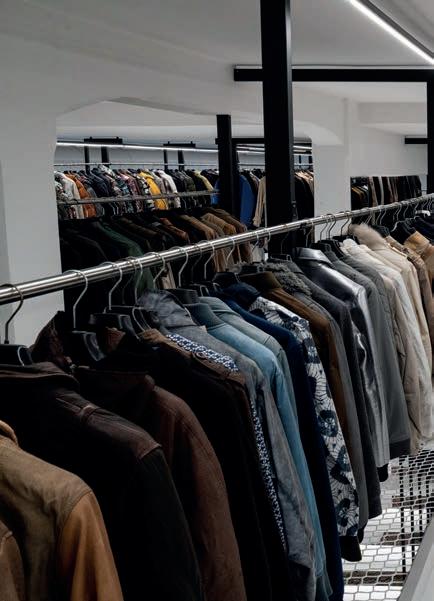

Lasciamo nelle pagine che seguono la parola di due dei protagonisti dell'impegno su
questi fronti ma prima non possiamo esimerci da un breve resoconto della visita allo stabilimento produttivo di Cantagallo. Caratterizzata da un notevole pregio architettonico sia nella struttura esterna sia negli spazi interni, confortevoli e ospitali la struttura produttiva della Divisione Tessuto di Beste con sede a Cantagallo è immersa nel verde dei primi contrafforti dell'Appennino pur essendo a poca distanza dal cuore del comprensorio pratese.
L'attenzione alla salubrità e alla pulizia dei reparti produt-
tivi si accompagna con il costante investimento nelle tecnologie più avanzate ma l'obiettivo della produttività e della qualità del prodotto non è mai disgiunto dalla ricerca dei cicli più opportuni e avanzati dal punto di vista del risparmio energetico, della riduzione delle emissioni e dell'utilizzo delle acque, della sicurezza sul lavoro e dell'impegno in termini di circolarità dei materiali.
L'archivio tessile, collocato nel cuore dell’azienda raccoglie tutte le produzioni succedutesi nel tempo. Si trova al centro
issue034
textures 36
SE PRATO È DA SECOLI SINONIMO DI RICICLO E CIRCOLARITÀ, L'IMPEGNO DI BESTE S.P.A., FIN DAI
A UNA DIMENSIONE INDUSTRIALE QUESTE ATTIVITÀ, RECUPERANDO
DISPERSIONE NELL'AMBIENTE E INSERENDOLI
CICLO PRODUTTIVO.
SUOI INIZI, PORTA
TESSILI DI OGNI TIPO DALLA
NEL SUO
SPAZIOGREENBESTE
Tommaso Gori, responsabile della produzione.
Luca Calamai, responsabile di ricerca &sviluppo.
Gli archivi di Beste Hub.
dell’area produttiva e raccoglie le cinque diverse collezioni tessili, tra cui la più antica: si trova al centro dell’area produttiva e raccoglie le cinque diverse collezioni tessili, tra cui la più antica: Beste tipicamente cotoniera a cui si è però aggiunta Texco, di recente acquisizione, che include nell’offerta escludivamnete fibre nobili quali: lana, cashemere, alpaca e tutte quelle fibre di orgine animale. Incrociamo nel corso della nostra visita una scolaresca in visita a testimonianza
del costante impegno di dialogo con la scuola e la formazione, caratteristica virtuosa del territorio pratese che trova in Beste uno dei sostenitori più convinti.
OBIETTIVO SOSTENIBILITÀ
Incontriamo, per approfondire il tema centrale della circolarità in Beste, Tommaso Gori, responsabile della produzione anche dal punto di vista della sostenibilità e Luca Calamai, responsabile di ricerca & svi-
SINCE UNSUSPECTING TIMES....
IF PRATO HAS BEEN SYNONYMOUS WITH RECYCLING AND CIRCULARITY FOR CENTURIES, THE COMMITMENT OF BESTE S.P.A., SINCE ITS INCEPTION, HAS BROUGHT THESE ACTIVITIES TO AN INDUSTRIAL DIMENSION, RECOVERING TEXTILES OF ALL KINDS FROM DISPERSION IN THE ENVIRONMENT AND INSERTING THEM INTO ITS PRODUCTION CYCLE.

Beste as part of Holding Moda, with a strong presence, of
luppo ma anche qui con un’accentuata e quasi totalizzante attività nel campo della ricerca
PIETRO FERRARI – Come gruppo industriale voi partite da un’azienda tradizionale… TOMMASO GORI – Si, ma il nostro fondatore Giovanni Santi ha subito avuto delle idee controcorrente: per cominciare ha iniziato a lavorare il cotone in un contesto laniero come quello pratese, poi ha cambiato molti aspetti della produzione, ottenendo nei english text
have been, if possible, pursued even further after the integration into Holding Moda. In the following pages we leave the word of two of the protagonists of the commitment on these fronts but first we cannot avoid a brief account of the visit to the Cantagallo production plant.
Characterized by a notable architectural value both in the external structure and in the comfortable and hospitable internal spaces, the production structure of the Beste Fabric Division based in Cantagallo is immersed in the greenery of the first foothills of the Apennines despite being a short distance from the heart of the Prato area.The attention to the healthiness and cleanliness of the production departments is accompanied by constant investment in the most advanced technologies but the objective of productivity and product quality is never separated from the search for the most appropriate and advanced cycles from the point of view of savings energy, reduction of emissions and use of water, safety at work and commitment in terms of circularity of materials. The textile archive, located in the heart of the company, collects all the productions that have taken place over time. It is located in the center of the production area and brings together the five different textile collections, including the oldest:
Beste is tipically a cotton manufacturer to which Texco, recently acquired, has been added, which includes in its offerings exclusively noble fibers such as: wool, cashemere, alpaca and all those fibers of animal origins - wool, cashmere, alpaca, mohair and so on. During our visit, we come across a visiting school group as evidence of the constant commitment to dialogue with the school and training, a virtuous characteristic of the Prato area that finds one of its most convinced supporters in Beste.
the Santi family, including Giovanni Santi, textile technician and founder of the comoany with different functions, Beste has always been very attentive to issues of sustainability, circularity and the maintenance of local know-how, values that
SUSTAINABILITY IS THE GOAL
To deepen the central theme of circularity in Beste, we meet Tommaso Gori, production manager also from the point of
textures 37
view of sustainability and Luca Calamai, Research & Development manager but here too with an accentuated and almost all-encompassing activity in the field of research
PIETRO FERRARI – As an industrial group you start from a traditional company…
TOMMASO GORI – Yes, but our founder Giovanni Santi immediately had some countercurrent ideas: initially, he began working cotton in a woolen context like the one in Prato, then he changed many aspects of production, obtaining visual effects in his textiles and very special touch. As Beste we have always been at the forefront of production process and that is why we have also been careful at the forefront in proposing innovative solutions. This represents one of the foundamental aspects of our reality. Another feature closely related to the previous one is the investment in technologies: mechanical, software, and logistics that allow to prevent waste and save energy always respecting the functionality of a quality production system.
PIETRO FERRARI – Does the theme of sustainability also get involved here?
LUCA CALAMAI – Our owner's idea is to evaluate each product from the point of view of sustainability, also going to sacrifice the margin on the product from a certain point of view, taking a fiber that costs much more but is characterized from real sustainability and not from sustainability told with advertising or similar purposes: a minimal improvement is negligible, innovation must be something that has a significant impact: for example, years ago we were the first to stop using waterproofing products that contain chlorinated compounds, the company made this choice even before the law expressly required it. From an energy point of view, there are plants set up to recover heat, or even the carbon dioxide that is emitted is practically used to adjust the ph of the outgoing wastewater. There are many interventions, sometimes difficult to communicate to an audience of non-specialists. However, the company carries them out in a targeted way to an effective sustainability effort.
PIETRO FERRARI – What is your role in the company?
LUCA CALAMAI – As a professional, I joined the company to cover a previously non-existent role, dedicating myself exclusively to research and development, freeing up the time of other people who obviously had other tasks. When I started my business at Beste, I realized that the owners were primarily interested in procedures and products that would make the company more sustainable.
PIETRO FERRARI – Including the problem of waste...
LUCA CALAMAI – A fundamental problem is waste: as in all companies, waste is generated, destined to be disposed of, because in the textile industry only the noble fibers are recovered. The request from the owner was to find a system to use also the scraps of the so-called "poor" fibres.

I began working on this project, not limiting myself to looking for solutions strictly in the textile industry but also contaminating these activities with other supply chains: initially there was satisfaction precisely in finding solutions gradually, arriving in the end not only to manage our waste but to offer a service to our customers by bringing us back waste, fully inserting ourselves in the management of our customers' packaging activity. This is because not only are we faced with a mountain of waste but we can ask for a selection of these waste when we arrive at a differentiated collection, because this is the only way to obtain their rational management. In addition to this, I deal with R&D in a broader sense with the research of new textile fibers and the improvement of existing production processes or treatments even if the recycling part occupies a high percentage of my time.
These are related topics: I have always dealt with materials such as carbon or glass fiber used in other supply chainsautomotive, aeronautics, space - for this reason I have always had a broader vision than just the textile sector. The management gave me free rein: this department which together provides research to customers, is like a start-up at the service of customers and our research and development needs.
TOMMASO GORI – The customer himself gives us some indications from which to start. Even the energy saving aspect is part of a mix of events under the impetus created by related industries, however we have always paid particular attention to this front: from this point of view we live and feel the problem of the lack of water since 2021-22 and we are working to make it more and more manageable.
issue034 https://beste.it textures 38
english text
SPAZIOGREENBESTE
suoi tessuti degli effettivi visivi e tattili molto particolari. Come Beste siamo sempre stati all’avanguardia nei processi produttivi e per questo siamo stati attenti all’avanguardia anche nella proposta di soluzioni innovative. Questo rappresenta uno degli aspetti fondanti alla base della nostra realtà. Un’altra caratteristica strettamente collegata con la precedente è l’investimento in tecnologie: meccaniche, di software e logistiche che consentono di prevenire sprechi e risparmiare energia sempre nel rispetto della funzionalità di un sistema produttivo di qualità.


PIETRO FERRARI – Qui si innerva anche il tema della sostenibilità?
LUCA CALAMAI – L’idea da parte del nostro titolare è quella di valutare ogni prodotto dal punto di vista della sostenibilità, andando anche a sacrificare da un certo punto di vista il margine sul prodotto, prendendo una fibra che costa
molto di più ma è caratterizzata da una sostenibilità reale e non da una sostenibilità raccontata con scopi pubblicitari o simili: un miglioramento minimo è trascurabile, l'innovazione dev’essere qualcosa che va a impattare in maniera rilevante: per esempio anni fa siamo stati i primi a smettere di utilizzare agenti impermeabilizzanti che contengono composti clorurati, l’azienda ha fatto questa scelta prima ancora che la legge lo richiedesse espressamente.
Dal punto di vista energetico, ci sono impianti impostati nella prospettiva di recuperare calore, o anidride carbonica che viene emessa e poi utilizzata per aggiustare le acque reflue in uscita. Sono tanti interventi, talvolta difficili da comunicare a un pubblico di non specialisti. L’azienda però li effettua in modo mirato a un effettivo sforzo di sostenibilità.
PIETRO FERRARI – Qual è il suo ruolo in azienda?
LUCA CALAMAI – Io, come professionista, sono entrato in
azienda per coprire un ruolo prima inesistente, dedicandomi esclusivamente all’attività di ricerca e sviluppo, liberando il tempo di altre persone che avevano ovviamente altri incarichi. Quando ho iniziato la mia attività in Beste, mi sono reso conto che ai titolari interessavano in primo luogo procedure e prodotti che rendessero l’azienda più sostenibile.
PIETRO FERRARI – Tra cui il problema degli scarti...
LUCA CALAMAI – Un problema fondamentale è quello degli scarti: come in tutte le aziende, essi vengono smaltiti, perchè nel tessile di norma solo le fibre nobili vengono recuperate. La richiesta da parte del titolare è stata quella di trovare un sistema per utilizzare anche gli scarti delle fibre cosiddette “povere”. Ho cominciato a lavorare su questo progetto, non limitandomi a cercare delle soluzioni strettamente nell’industria tessile ma contaminando anche queste attività con altre filiere: inizial-
textures 39
La divisione abbigliamento.
THE BEREDO SOLUTION
PIETRO FERRARI – Does Beredo also fit into this context? How did the idea of Beredo come about?
TOMMASO GORI – The idea was born on the great problem of unsold goods: internally we thought that all that excellent raw material could interest us and instead of incinerating or disposing of it, a circular path could be the ideal basis.
PIETRO FERRARI – I understand that here sustainability is brought to an industrial dimension…
LUCA CALAMAI – In fact, either you make a selection upstream of the fibers or you end up throwing everything in the landfill…
PIETRO FERRARI – We can no longer afford to make symbolic gestures but even recycling must reach an industrial dimension. And here we are looking for the industrial impact, does this imply a sacrifice from the point of view of the prices charged?


TOMMASO GORI – Certainly, maintaining the efficiency of "sustainable" plants and selecting products based on the needs of sustainability require a fairly important economic effort. Fortunately we are positioned in a market, the luxury one, which has understood that, in any case, sustainability has a cost but this cost is willing to pay.
Over the years we have seen a clear division: luxury brands are making a choice in terms of suppliers, capable of ensuring traceability also on sustainability by the public. Certification has partially lost its value, because everyone has certifications, as happened to the measurement indexes of parameters. The end user must understand and perceive the complexity of the theme to avoid an excessive prolife-
ration of certifications and purely symbolic solutions. The Beredo initiative was created to add the term circularity to the term sustainability: investments in this sense are clearly visible in the production departments. A lot of work needs to be done on pre-consumering which has a formidable volume, meaning by pre-consumption the gigantic volume of finished products ready to enter the market but which for one reason or another cannot make it either in the form of fabric or under head shape. It is important that this mass of textile product is brought to new life.
TRANSVERSALITY AS A SOLUTION
LUCA CALAMAI – What is important is to look for transversality between industrial sectors: the ambition to use all the material only in the clothing and furniture sector greatly limits the possibilities. So we went looking for transversality in order to have solutions to offer to our customers and, I must say, that after three years of research, trials and attempts we have achieved good results. To give some examples, we are able to create packaging, wrapping paper or other that can be reused by the brand that supplies the material, or exist for other uses: if I can't get a yarn or fabric suitable for making a dress, this can be used to make a garment cover or similar products. Then there are all the various categories of products in which the recovered waste is refined, to be used for small details, which go into the automotive sector, or into accessories such as pallets, useful in logistics. In summary, the more the different needs of the industry intersect, the more solutions are found that are circular together in the various sectors with increasingly large possible intersections, otherwise the field of action is
issue034 https://beste.it textures 40 SPAZIOGREENBESTE english text
Tessitura Serena.
mente c’era soddisfazione proprio nel trovare via via delle soluzioni, arrivando non solo a gestire i nostri scarti ma ad offrire ai nostri clienti un servizio legato ad essi: recuperandoli, inserendoli nuovamente nella gestione dell’attività di confezione.
Questo perchè non solo ci troviamo davanti a una montagna di scarti ma possiamo, qualora ci fosse collaborazione delle realtà con cui operiamo, organizzare una logica di separazione primaria in modo tale da riuscire a categorizzare le soluzioni delle fasi successive.
Oltre a questo io mi occupo di R&D in senso lato con la ricerca di nuove fibre tessili e il miglioramento di processi produttivi o dei trattamenti esistenti anche se poi la parte di riciclo occupa un'alta percentuale del mio tempo.

Sono argomenti correlati: mi sono sempre occupato di materiali come la fibra di carbonio o di vetro utilizzati in altre
filiere - automotive, aeronautico, spaziale - per questo ho sempre avuto una visione più ampia rispetto al solo settore tessile.
La direzione mi ha lasciato carte bianca: questo dipartimento che assieme fornisce ricerca ai clienti, è come una start up al servizio dei clienti e delle nostre necessità di ricerca e sviluppo.
TOMMASO GORI – Il cliente stesso ci dà delle indicazioni da cui partire. Anche l’aspetto del risparmio energetico fa parte di un mix di eventi sotto la spinta creata all’indotto, comunque noi abbiamo sempre avuto un’attenzione particolare su questo fronte: da questo punto di vista noi viviamo e sentiamo il problema della carenza d’acqua già dal 2021-22 e lavoriamo per rendere sempre più gestibile e meno impattante possibile la gestione dell'acqua.
LA SOLUZIONE BEREDO
PIETRO FERRARI – In que-
sto contesto si colloca anche Beredo? Come è nata l’idea di Beredo?
TOMMASO GORI – L’idea è nata dal grande problema dell’invenduto: internamente abbiamo pensato che tutta quella materia prima ottima poteva interessarci e invece di incenerirla o di smaltirla poteva essere la base ideale ci un percorso circolare.
PIETRO FERRARI – A me sembra di capire che qui la sostenibilità viene portata a una dimensione industriale…
LUCA CALAMAI – Infatti o si fa una selezione a monte delle fibre o si finisce per buttare tutto in discarica…
PIETRO FERRARI – Non possiamo più permetterci di fare gesti simbolici ma anche il riciclo deve arrivare a una dimensione industriale. E qui si cerca l’impatto industriale, questo implica un sacrificio dal punto di vista dei prezzi praticati?
TOMMASO GORI – Certamente mantenere in efficienza

textures 41
degli impianti “sostenibili” e selezionare i prodotti in base alle esigenze della sostenibilità richiedono uno sforzo economico abbastanza importante. Fortunatamente siamo posizionati in un mercato, quello del lusso, che ha capito che, comunque, la sostenibilità ha un costo ma questo costo è disposto a pagarlo.
Negli anni stiamo vedendo una netta divisione: i brand del lusso stanno facendo una scelta in termini di fornitori, in grado di assicurare tracciabilità anche sulla sostenibilità da parte del pubblico. Ha perso in parte di valore la certificazione, perché tutti hanno certificazioni, così come è accaduto agli indici di misura-
zione di parametri. Occorre che l’utente finale capisca e percepisca la complessità del tema per evitare una proliferazione eccessiva di certificazioni e di soluzioni puramente simboliche.
L’iniziativa Beredo nasce per aggiungere al termine sostenibilità il termine circolarità: gli investimenti in questo senso
limited. We have to find outlets for really very high quantities, nothing to do with the classic recovery which is a noble activity which, however, cannot cope with these volumes and is limited to fine fibers.
TOMMASO GORI – It is important that the supply chain is short and at a reasonable distance. It is absurd that we go to get recyclable raw material from China, India or Pakistan: our intention is to count on a series of industrial partners located in very close areas otherwise all the advantage of recycling in costs and impacts is lost environmental logistics: therefore short and close supply chains. We have also found many in different sectors, both in Tuscany and in Italy.
PIETRO FERRARI – From the point of view of chemistry, what was your approach?
LUCA CALAMAI – When I see a waste it is a material for me: when I look at a cotton waste it is cellulose for me and it finds use in all sectors where it can be used, it is a raw material that can be very interesting to use with composite materials, made of rigid felts or printed materials with completely different products from the starting ones (buttons, shoe heels) that find their place in the fashion chain or in others.
Chemistry has the function of separating the fibrous mixtures that are difficult to recover: the ideal would be ecodesign which already in the project avoids the mixing of materials that are very difficult to manage, the other possibility is to intervene on the processes that can separate
sono ben visibili nei reparti produttivi. Occorre lavorare molto sul pre-consumering che ha un volume formidabile, intendendo per pre-consumo il volume gigantesco dei prodotti finiti pronti per entrare nel mercato ma che per un motivo o per l’altro non ce la fa né sotto forma di tessuto né sotto forma di capo. È importante che que-
these fibrous blends, here, as Beste researches, we have two pending patents on systems that allow you to go and separate two fibers, natural and synthetic, by exploiting the different solubility of these types of fibers or their different specific weights. This is one of the major ongoing challenges in textile fiber management.
PIETRO FERRARI – What are your goals in terms of sustainability today?
TOMMASO GORI – Let's start from the plant: we certainly have a series of investments on the plate to be able to effectively become independent from the point of view of water resources, that would be a very important result with a reduction in withdrawals and an almost total recovery of our waste water. Secondly, we are coming to produce our electricity from renewable sources with the acquisition of other buildings covered with ever-increasing surfaces of solar panels to reach up to reach up to a thirty percent of self generated consumption . On the other hand we are investing heavily in research to reduce the impact of dyes with the careful evaluation of some dyeing techniques that are maturing, from CO2 to bacterial culture, we want to actively participate in these developments. In Prato there are still some producers of textile materials combined with two or three research centers that are able to provide new ideas.
LUCA CALAMAI – All this without forgetting the issue of training which must be constantly pushed, because it is one of the critical points of the textile sector.

issue034 https://beste.it textures 42 SPAZIOGREENBESTE
english text
Panoramica di Monobi.
sta massa di prodotto tessile venga portata a nuova vita.
LA TRASVERSALITÀ COME SOLUZIONE
LUCA CALAMAI – Quello che è importante è andare a cercare la trasversalità tra settori industriali: l’ambizione di utilizzare tutto il materiale solo nel settore dell’abbigliamento e dell’arredamento limita molto le possibilità. Quindi siamo andati a cercare trasversalità per poter avere delle soluzioni da proporre ai nostri clienti e, devo dire, che, dopo tre anni di ricerche, prove e tentativi siamo arrivati a buoni risultati. Per fare alcuni esempi riusciamo a realizzare packaging, carta da imballo o altro che possono essere riutilizzati dal brand stesso che fornisce il materiale, oppure esistere per altri impieghi: se non riesco a ottenere un filato o un tessuto idoneo a farci un abito, questo può essere utilizzato per realizzare un copriabiti o prodotti simili.
Ci sono poi tutte le varie categorie di prodotti in cui si va a rifinire lo scarto recuperato, per utilizzarlo per piccoli particolari, che vanno nell’automotive, oppure in accessori come pallet, utili nella logistica. In sintesi più si incrociano le diverse esigenze dell’industria più si trovano soluzioni che sono circolari assieme nei diversi settori con intersezioni sempre più grandi possibili, altrimenti si limita il campo di azione. Dobbiamo trovare degli sbocchi per delle quantità veramente altissime, nulla a che fare col classico recupero che è un’attività nobile che non riesce però a far fronte a questi volumi e si limita a fibre pregiate.
TOMMASO GORI – È im-
portante che la filiera sia corta e a distanza ragionevole. È assurdo che si vada a prendere materia prima riciclabile da Cina, India o Pakistan: l’intento nostro è quello di contare su di una serie di partner industriali localizzati in aree molto vicine altrimenti si disperde tutto il vantaggio del riciclo in costi e impatti ambientali di logistica: dunque filiere corte e vicine. Ne abbiamo trovate tante anche in settori diversi, sia in Toscana sia in Italia.
PIETRO FERRARI – Dal punto di vista della chimica, qual è stato il vostro approccio?
LUCA CALAMAI – Quando vedo uno scarto per me è un materiale: quando guardo uno scarto di cotone per me è cellulosa e trova utilizzo in tutti i settori dove può servire, è una materia prima che può essere molto interessante utilizzare con materiali compositi, fatti di feltri rigidi o materiali stampati con prodotti completamente diversi da quelli di partenza (bottoni, tacchi da scarpa) che trovi collocamento nella filiera della moda o in altre.
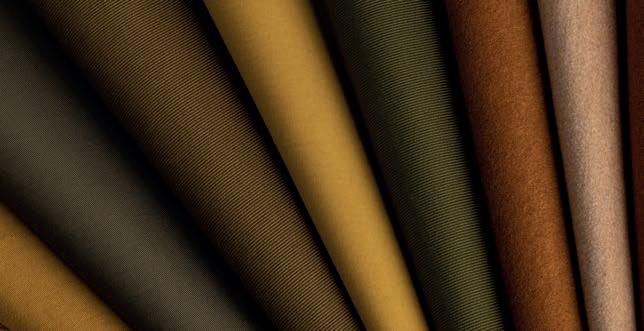
La chimica ha la funzione di separare le miste fibrose difficili da recuperare: l’ideale sarebbe l’ecodesign che già nel progetto evita la mescolanza di materiali molto difficili da gestire, l’altra possibilità è quella di intervenire sui processi che possono arrivare a separare queste miste fibrose, qui, come ricerca Beste, abbiamo due patent pending su sistemi che consentono di andare a separare due fibre, naturali e sintetiche, sfruttando la diversa solubilità di questi tipi di fibre o i loro diversi pesi specifici. Questa è una delle sfide principali in corso nella gestione delle fibre tessili.
PIETRO FERRARI – Quali sono oggi i vostri traguardi a livello di sostenibilità?
TOMMASO GORI – Partiamo dallo stabilimento: sicuramente abbiamo sul piatto una serie di investimenti per poter diventare effettivamente indipendenti dal punto di vista della risorsa idrica, quello sarebbe un risultato molto importante con una riduzione del prelievo e un recupero quasi totale delle nostre acque di scarico. In secondo luogo stiamo arrivando a produrre la nostra energia elettrica da fonti rinnovabili con l’acquisizione di altri immobili coperti con superfici sempre maggiori di pannelli solari per arrivare fino a un trenta per cento di consumi autogenerati. D’altro canto stiamo investendo molto in ricerca per diminuire l’impatto delle tinture con l’attenta valutazione di alcune tecniche tintoriali che stanno maturando, dalla CO2 alla coltura batterica, volgiamo partecipare in maniera attiva a questi sviluppi. A Prato ci sono ancora alcuni produttori di materiali tessili abbinati a due o tre centri di ricerca che sono in grado di fornire spunti nuovi. LUCA CALAMAI – Tutto questo senza dimenticare il tema della formazione che va costantemente spinta, perché è uno dei punti critici del settore tessile.
textures 43
Un ventaglio di tessuti.
IL PATTO DELL'INDUSTRIA DEL FASHION PER PROTEGGERE LE FORESTE DEL MONDO
Nello sforzo continuo di ridurre il più possibile i propri impatti, molti marchi della moda negli ultimi anni hanno scelto di sostituire le fibre sintetiche, derivate dalla plastica, con le fibre cellulosiche artificiali (Man-Made Cellulosic Fibers, MMCF) che possono essere estratte dalla polpa di cellulosa.
Le MMCF rappresentano così la quota in più rapida crescita nella produzione globale di fibre, ma secondo dati Textile Exchange oltre il 50% deriva oggi da foreste naturali non gestite. Ciò minaccia molte aree, lasciandole vulnerabili alla deforestazione e al disboscamento illegale.
Un approccio sostenibile all'uso delle MMCF richiede quindi una protezione forestale a lungo termine, capace di limitare gli impatti negativi e consentire l'approvvigionamento di fibra senza distruggere le aree di origine.
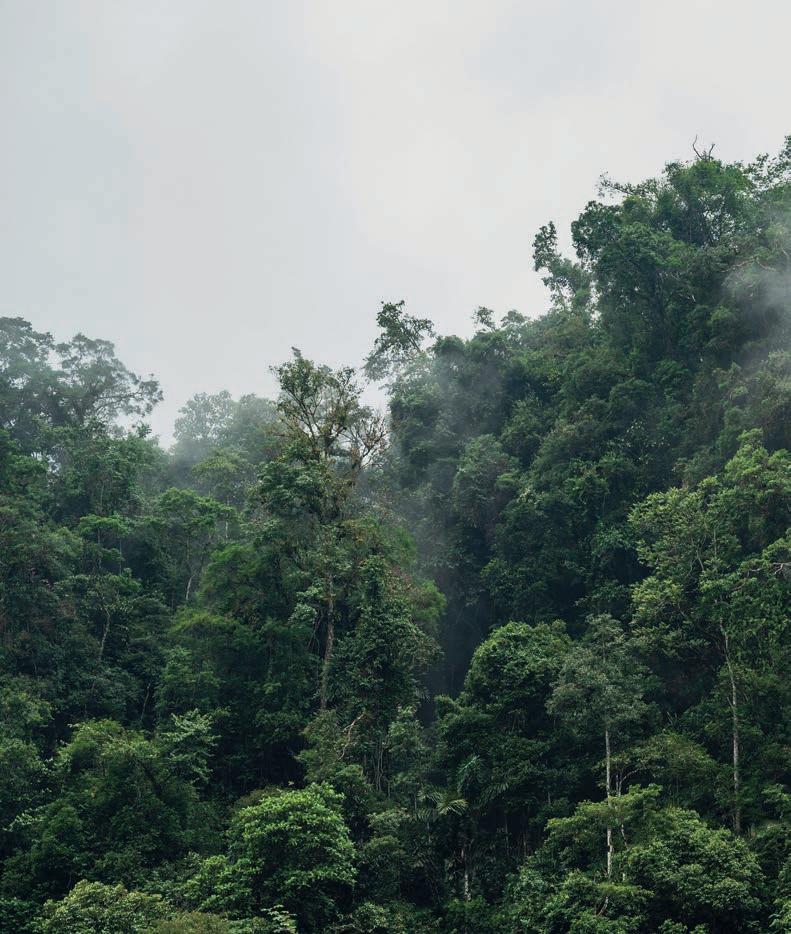
issue034 writer FSC® www.fashionforevergreen.org textures 44
SI CHIAMA FASHION FOREVER GREEN PACT, ED È L'INIZIATIVA LANCIATA DAL FOREST STEWARDSHIP COUNCIL (FSC®) CHE CHIEDE A BRAND, RETAILER E PRODUTTORI DI ADOTTARE POLITICHE DI APPROVVIGIONAMENTO RESPONSABILE A SOSTEGNO DELLA BIODIVERSITÀ E DEGLI ECOSISTEMI FORESTALI GLOBALI.
SPAZIOGREENFSC® FOREST STEWARDSHIP COUNCIL
Creato nel 2021 dal Forest Stewardship Council (FSC®), ONG globale che da 30 anni promuove la gestione responsabile di foreste e piantagioni, il Fashion Forever Green Pact (www.fashionforevergreen.org) è uno strumento che aiuta l'industria della moda a definire politiche di approvvigionamento responsabile, attraverso 3 step: l'adesione alla CanopyStyle Iniziative per affrontare i potenziali rischi derivanti dall'uso di cellulosa nella produzione di fibre; l’uso di fibre



cellulosiche certificate FSC® da fornitori certificati; l'etichettatura FSC® dei capi a garanzia della trasparenza della filiera.
Al Patto hanno già aderito marchi e produttori internazionali come: Enka, Brunello, Ghezzi, ItalTex, Edoardo Miroglio, Gruppo Colombo, Ezio Ghiringhelli, Torcitura Fibre Sintetiche , Eastman/Naia, Masai, Jackytex, JBS e Birla.
textures 45
FASHION INDUSTRY’S PACT TO PROTECT THE WORLD'S FORESTS
THE FASHION FOREVER GREEN PACT IT’S AN INITIATIVE LAUNCHED BY THE FOREST STEWARDSHIP COUNCIL (FSC®) WHICH CALLS FOR BRANDS, RETAILERS AND PRODUCERS TO ADOPT RESPONSIBLE SOURCING POLICIES IN SUPPORT OF BIODIVERSITY AND GLOBAL FOREST ECOSYSTEMS.
In the continuous effort to reduce their impacts as much as possible, many fashion brands in recent years have chosen to replace synthetic fibers derived from plastic with manmade cellulosic fibers (MMCFs), which can be extracted from cellulose pulp. MMCFs thus represent the fastest growing share in global fiber production, but according to Textile Exchange data, today more than 50% comes from natural, not-managed forests. This threatens many areas, leaving them vulnerable to deforestation and illegal logging.

A sustainable approach to the use of MMCFs therefore re-
quires long-term forest protection, capable of limiting negative impacts and allowing the supply of fiber without destroying the areas of origin.
Created in 2021 by the Forest Stewardship Council (FSC®), a global NGO that has been promoting the responsible management of forests and plantations for 30 years, the Fashion Forever Green Pact (www.fashionforevergreen.org) is a tool that helps the fashion industry define responsible procurement policies, through 3 steps: joining the CanopyStyle Initiative to address the potential risks deriving from the use of cellulose in fibres production; using FSC®- certified cellulosic fibers from certified suppliers; FSC®-labeling the garments to guarantee the transparency of the supply chain.
International brands and producers such as Enka, Brunello, Ghezzi, ItalTex, Edoardo Miroglio, Gruppo Colombo, Eastman/Naia, Masai, JBS and Birla have already joined the Pact.
issue034 www.fashionforevergreen.org textures 46
english text
SPAZIOGREENFSC® FOREST STEWARDSHIP COUNCIL
Un mondo dove foreste e fashion coesistono è possibile.

Le fibre tessili cellulosiche d’origine forestale come la viscosa, il modal, il lyocell e l’acetato di cellulosa rappresentano una quota importante della produzione globale di fibre, ma oltre il 50% proviene da foreste non certificate. Ciò minaccia le aree di origine, rendendole vulnerabili alla deforestazione e al degrado.
Brand di moda e produttori possono essere parte del cambiamento positivo, scegliendo di assicurare un approvvigionamento responsabile delle fibre tessili cellulosiche grazie alla certificazione FSC®
La certificazione FSC assicura infatti che le fibre tessili di origine forestale derivino da fonti gestite responsabilmente e siano tracciate dal punto di approvvigionamento fino al consumatore.
Scopri di più su fashion.fsc-italia.it.
writer Paola Govoni
TRANSITIONS. CONTAMINAZIONE VIRTUOSA FRA ARTE E MODA A FIRENZE

I decenni che vanno dalla caduta del Muro di Berlino alla Pandemia hanno segnato una nuova era, un’epoca di ‘transizione’ dall’infanzia alla età adulta, passando dai Millennials alla Generazione Z, la prima che non evidenzia una rottura con la generazione precedente, ma si dimostra più aperta al dialogo e spontaneamente più orientata a miscelare codici diversi per dare vita a nuovi linguaggi all’insegna della multiculturalità e della multidisciplinarietà.
In tal modo, Moda, Arte, Design, Comunicazione, Musica e Tecnologia si mescolano e interagiscono in un processo virtuoso, in cui il Mass Marketing viene percepito come non più sostenibile, il Lusso tende a nascondersi e a diventare Quiet Luxury, i nuovi modelli di Urbanistica Green e più in generale i temi di Tutela Ambientale, Sostenibilità, Riciclo e Rigenerazione sono oggetto di sempre maggiore attenzione.
Lo IED, Istituto Europeo di Design, è da sempre orientato a comunicare una visione ispirata alla ‘Transdisciplinarietà’ e a situare il senso delle attività
issue034
textures 48
ART AND TEXTILE
Paola Govoni all’ingresso della installazione TRANSITIONS a Firenze.
e del fare nella cornice del Genius Loci e dello Zeitgeist, in una contemporaneità fluida, anche attivando relazioni che producono cultura e co-creazione. Questo significa uscire dalla zona di comfort attraverso l’esplorazione di nuovi territori, anche in una condizione di autocritica e di rischio, che possano generare nuovo pensiero, movimento e creazione.
FIRENZE SVELA TRANSITIONS
Lo scorso mese di giugno, in occasione di Pitti Uomo 2023 a Firenze, IED ha svelato nel Salone Brunelleschi dell’Istituto degli Innocenti l’installazione TRANSITIONS, espressione di come la riflessione della moda si leghi spontaneamente a quella dell’arte. Interpreti del progetto un gruppo di otto studenti di Fashion Design selezionati dalle sedi del Gruppo IED e guidati dalla mentor Lucy Orta, artista visiva internazionale nota per il suo talento straordinario in grado di unire disegno, scultura, tessile, fotografia, cinema, performance e di affrontare temi che riguardano il contemporaneo con un linguaggio innovativo di cocreazione.


Attraverso l'uso di materiali e di elementi formali ricorrenti, l’installazione ha creato un campo comune dentro il quale è stato interpretato il concept di Transitions.
Un grande stage accoglieva i diversi progetti che dialogavano fra loro e abitavano lo spazio del Salone Brunelleschi con un lavoro corale e allo stesso tempo multiforme. Gli studenti sono stati chiamati a decodificare il termine tran-
sizione inteso come momento di passaggio e di complessità che ogni cambiamento comporta: ogni transizione è la conseguenza di una necessità di adattamento a una crisi che permette al contempo di progettare un futuro diverso. Ogni transizione è un passaggio che ripensa le forme dell'umano dal punto di vista sociale, ecologico, tecnologico.
«Sono lieta di avere fatto da
mentore al gruppo di talentuosi studenti internazionali IED in questa tappa fondamentale del loro percorso creativo. Le loro risposte creative ne dimostrano il ruolo da protagonisti di un mondo futuro in cui dovremo abitare.
I giovani designer si misurano con instabilità ambientale e molteplici timori, per immaginare scenari positivi e adattivi. In una mostra che induce alla riflessione vedremo una serie di idee speculative: futuri abi-
textures 49
(da sinistra) Riccardo Balbo direttore accademico Gruppo IED, Lucy Orta Mentor del progetto TRANSITIONS, Danilo Venturi Direttore IED Firenze.
Il gruppo degli 8 studenti di Fashion Design interpreti del progetto TRANSITIONS.
tati da esseri con identità multiple e ibridi uomo-natura-macchina del Novacene, abiti disegnati dall’Intelligenza Artificale generativa, tessuti che emettono canzoni o crescono in autonomia prima di essere riassorbiti naturalmente nella terra.
La mostra all’Istituto degli Innocenti è un’installazione fertile e un incubatore per le molteplici
interpretazioni del tema ‘Transizione’ tra moda, film e performance, collocate in un dialogo critico, cui il pubblico è invitato a partecipare» ha dichiarato Lucy Orta, artista e Chair of Art and the Environment, University of the Arts London.






«Siamo nel Salone Brunelleschi dell’Istituto degli Innocenti, nel centro storico di Firenze du-
rante una delle settimane più aperte al mondo dell’anno –ha dichiarato Riccardo Balbo, Direttore Accademico Gruppo IED – eppure TRANSITIONS non è solo l’oggi ma una proiezione sul futuro di IED e sul modo di fare scuola di tutto il Gruppo. Transitions esprime il movimento, il cambiamento da una condizione a un’altra. Questi passaggi sono come
issue034 textures 50
ART AND TEXTILE
dei ponti, delle connessioni, ibridazioni fra discipline e linguaggi apparentemente lontani che creano il nuovo, come accade nell’incontro tra l’arte e la moda. Abbiamo scelto Lucy Orta proprio perché in lei abbiamo riconosciuto un artista e mentor in grado di contaminare ad altissimi livelli, connettere, leggere il contemporaneo e intendere la moda come un’espressione critica dell’arte».
Mesi di lavoro in team hanno portato alla realizzazione di una grande installazione dove tutti i progetti, ognuno nella propria individualità, risuonano in una visione complessiva. L’installazione ha ampliato il terreno della moda includendo elementi performativi, disegni, immagini fotografiche e video. Qui, i giovani Fa-

TRANSITIONS. VIRTUOUS CONTAMINATION BETWEEN ART AND FASHION IN FLORENCE
shion Designers si sono raccontati come futuri protagonisti attivi di un mondo che dovranno abitare, i progetti sono diventati lo strumento attraverso cui esprimere i rispettivi punti di vista sui temi che più sentono urgenti del mondo contemporaneo.
La scelta dell’Istituto degli Innocenti come location, ha voluto sottolineare l’attenzione ai grandi temi umani e sociali, terreno comune alla missione formativa IED, scuola e luogo di produzione critica in costante dialogo con le istituzioni, e anche incubatore di idee e di processi da sviluppare e presentare in occasioni di confronto internazionale con il settore produttivo della moda come quello di Pitti.
Questi i progetti di Transitions:
• Fluvoxamina performance di interazione libera con capsule collection di Gaia Invernizzi
- IED Milano
• Jano Bikoitza video e outfit di Marcos Escobar Aguirre - IED Madrid
• The Transition of Silence performance con tessuti e materiali sonori di Luca Mantovani - Accademia Aldo Galli di Como
• Dizygoth capsule collection di capi tecnici e materiali di ricerca sulle bioplastiche di Carolina Puiggròs Figueras - IED Barcelona
• From Flesh to Code, A Dialogue on Transition performance di Michele Serra - IED Cagliari
• Prodigy capsule collection e performance ispirate all’uomo-gargoyle di Riccardo Lerda -
IED Torino
• Body of Transformations, Transformations of Body installazione di Federica Borzì - IED Firenze

• Survive zaino di Livio Pilla - IED Roma
The decades that go from the fall of the Berlin Wall (1989) to the Pandemic (2020) have marked a new era, an era of 'transition' from childhood to adulthood, passing from Millennials to Generation Z, the first which does not highlight a break with the previous generation, but proves to be more open to dialogue and spontaneously more oriented towards mixing different codes to give life to new languages under the banner of multiculturalism and multidisciplinarity.
english text
In this way, Fashion, Art, Design, Communication, Music and Technology mix and interact in a virtuous process, in which Mass Marketing is perceived as no longer sustainable, Luxury tends to hide and become Quiet Luxury, the new models of Green Urban Planning and more generally the issues of Environmental Protection, Sustainability, Recycling and Regeneration are the subject of increasing attention. The IED, Istituto Europeo di Design, has always been oriented towards communicating a vision inspired by 'Transdisciplinarity' and locating the meaning of activities and doing within the framework of the Genius Loci and the Zeitgeist, in a fluid contemporaneity, also by activating relationships that produce culture and co-creation.
textures 51
This means getting out of the comfort zone through the exploration of new territories, even in a condition of self-criticism and risk, which can generate new thought, movement and creation.
FLORENCE UNVEILS TRANSITIONS
Last June, on the occasion of Pitti Uomo 2023 in Florence, IED unveiled the TRANSITIONS installation in the Brunelleschi Hall of the Istituto degli Innocenti, an expression of how the reflection of Fashion is spontaneously linked to that of Art. The project was interpreted by a group of eight Fashion Design students selected from the IED Group offices and led by mentor Lucy Orta, an international visual artist known for her extraordinary talent capable of combining drawing, sculpture, textiles, photography, cinema, performance and address issues that concern the contemporary with an innovative language of co-creation. Through the use of materials and recurring formal elements, the installation created a common field within which the Transitions concept was interpreted.
A large stage welcomed the various projects that interacted with each other and inhabited the space of the Brunelleschi Hall with a choral and at the same time multifaceted work. The students were asked to decode the term transition understood as a moment of transition and complexity that every change entails: every transition is the consequence of a need to adapt to a crisis that allows at the same time to plan a different future. Each transition is a passage that rethinks human forms from a social, ecological and technological point of view.
“I am delighted to have mentored the group of talented international IED students in this milestone of their creative journey. Their creative responses demonstrate their role as protagonists of a future world in which we will have to inhabit. Young designers measure themselves against environmental instability and multiple fears, to imagine positive and adaptive scenarios. In a thought-provoking exhibition we will see a series of speculative ideas: futures inhabited by beings with multiple identities and Novacene man-nature-machine hybrids, clothes designed by generative Artificial Intelligence, fabrics that emit songs or grow autonomously before being naturally reabsorbed into the earth. The exhibition at the Istituto degli Innocenti is a fertile installation and an incubator for the multiple interpretations of the theme 'Transition' between fashion, film and performance, placed in a critical dialogue, in which the public is invited to participate,” said Lucy Orta, artist and Chair of Art and the Environment, University of the Arts London.
“We are in the Brunelleschi Hall of the Istituto degli Innocenti, in the historic center of Florence during one of the
most open weeks of the year to the world – said Riccardo Balbo, Academic Director of the IED Group – yet TRANSITIONS is not only today but a projection on future of IED and on the whole Group's way of teaching. Transitions expresses the movement, the change from one condition to another. These passages are like bridges, connections, hybridizations between seemingly distant disciplines and languages that create the new, as happens in the encounter between art and fashion. We chose Lucy Orta precisely because in her we recognized an artist and mentor capable of contaminating at the highest levels, connecting, reading the contemporary and understanding fashion as a critical expression of art."
Months of team work have led to the creation of a large installation where all the projects, each in its own individuality, resonate in an overall vision. The installation broadened the terrain of fashion to include performative elements, drawings, photographic and video images. Here, the young Fashion Designers have described themselves as future active protagonists of a world they will have to inhabit, the projects have become the tool through which to express their respective points of view on the themes they feel most urgent in the contemporary world.
The choice of the Istituto degli Innocenti as the location wanted to underline the attention to the great human and social themes, common ground to the IED educational mission, a school and place of critical production in constant dialogue with the institutions, and also an incubator of ideas and processes to be developed and presented on occasions for international comparison with the fashion manufacturing sector such as that of Pitti.
These are the Transitions projects:
• Fluvoxamina free interaction performance with capsule collection by Gaia Invernizzi - IED Milano
• Jano Bikoitza video and outfit by Marcos Escobar Aguirre
- IED Madrid
• The Transition of Silence performance with fabrics and sound materials by Luca Mantovani - Aldo Galli Academy in Como
• Dizygoth capsule collection of technical garments and research materials on bioplastics by Carolina Puiggròs Figueras - IED Barcelona
• From Flesh to Code, A Dialogue on Transition performance by Michele Serra - IED Cagliari
• Prodigy capsule collection and performances inspired by the gargoyle-man by Riccardo Lerda - IED Turin
• Body of Transformations, Transformations of Body installation by Federica Borzì - IED Florence
• Survive backpack by Livio Pilla - IED Rome
issue034 textures 52 english text ART AND TEXTILE
ISTITUTO EUROPEO DI DESIGN - IED
IED è un Gruppo internazionale, il più grande Network di Alta Formazione in ambito creativo ad aver mantenuto dal 1966 uno sguardo globale e una matrice culturale profondamente italiana. È presente con 11 sedi in 3 paesi: in Italia a Milano, Cagliari, Firenze, Roma, Torino e a Como con l’Accademia di Belle Arti Aldo Galli; in Spagna a Barcellona, Madrid e Bilbao e in Brasile a Rio de Janeiro e San Paolo. In Italia, IED opera attraverso la capogruppo che nel 2022 è stata trasformata in una Società Benefit con l’obiettivo di formalizzare il suo impatto positivo sulla società e sul pianeta. IED è una scuola inclusiva e transdisciplinare che utilizza il design come linguaggio universale per il cambiamento. Ogni anno avvia progetti di innovazione in ambito formativo nelle discipline del Design, della Moda, della Comunicazione e del Management, delle Arti Visive, dell’Arte e del Restauro, sviluppando forme di apprendimento e nuovi modelli per interpretare il futuro. IED può contare su una rete di oltre 3.000 docenti, attivi nei rispettivi settori di riferimento, con cui collabora costantemente per assicurare il perfetto svolgimento delle attività di formazione delle sue sedi.
EUROPEAN INSTITUTE OF DESIGN - IED
IED is an international Group, the largest Higher Education Network in the creative field to have maintained a global outlook and a profoundly Italian cultural matrix since 1966. It is present with 11 branches in 3 countries: in Italy in Milan, Cagliari, Florence, Rome, Turin and in Como with the Aldo Galli Academy of Fine Arts; in Spain in Barcelona, Madrid and Bilbao and in Brazil in Rio de Janeiro and São Paulo. In Italy, IED operates through the partner company which in 2022 was transformed into a Benefit Company with the aim of formalizing its positive impact on society and the planet. IED is an inclusive and transdisciplinary school that uses design as a universal language for change. Every year it launches innovation projects in the field of education in the disciplines of Design, Fashion, Communication and Management, the Visual Arts, Art and Restoration, developing forms of learning and new models for interpreting the future. IED can count on a network of over 3,000 teachers, active in their respective reference sectors, with whom it collaborates constantly to ensure the perfect performance of the training activities of its institutes.
LUCY ORTA
Nata in Gran Bretagna (1966). La pratica delle arti visive di Lucy Orta indaga le interrelazioni tra il corpo individuale e le strutture comunitarie, esplorandone le diverse identità e le modalità di convivenza. Utilizza i mezzi del disegno, della scultura tessile, della fotografia, del cinema e della performance per realizzare opere singolari. Il suo processo di rappresentazione delle voci della comunità incorpora metodi di co-creazione e inclusione e ha collaborato con un'ampia gamma di persone, spesso ai margini dell'esclusione, per rafforzare i partecipanti attraverso una pratica creativa condivisa. A riconoscimento della sua innovativa pratica di ricerca socialmente impegnata, Lucy Orta è stata nominata Head of the Man & Humanity, un programma di master pionieristico per il design sostenibile, che ha co-fondato con Li Edelkoort presso la Design Academy Eindhoven, nel 2002. Dal 2002 è docente presso il London College of Fashion e attualmente è titolare della cattedra di Art and the Environment presso la University of the Arts di Londra, dove ha fondato il programma Art for the Environment Artist in Residency Program. In riconoscimento del suo contributo accademico alle arti visive, ha ricevuto un Master of Arts onorario dalla Nottingham Trent University e un Doctor of Letters onorario dall'Università di Brighton.
LUCY ORTA
Born in Great Britain (1966). Lucy Orta's practice of visual arts investigates the interrelationships between the individual body and community structures, exploring their different identities and ways of living together, using the means of drawing, textile sculpture, photography, cinema and performance to create singular works. Her process of representing community voices incorporates methods of co-creation and inclusion, and she has collaborated with a wide range of people, often on the fringes of exclusion, to empower participants through a shared creative practice. In recognition of her innovative socially engaged research practice, Lucy Orta was made Head of the Man & Humanity, a pioneering masters program for sustainable design, which she co-founded with Li Edelkoort at the Design Academy Eindhoven, in 2002. She has been a lecturer at the London College of Fashion since 2002 and currently holds the chair of Art and the Environment at the University of the Arts London, where she founded the Art for the Environment Artist in Residency Programme. In recognition of her academic contributions to the visual arts, she has been awarded an honorary Master of Arts from Nottingham Trent University and an honorary Doctor of Letters from the University of Brighton.
textures 53
LA LANA VESTE L’INTERIOR
Con il progetto “TOLLEGNO 1900 BLANCKET DRESSING”, presentato alla scorsa edizione di Pitti, la lana ha offerto nuove interpretazioni dell’interior design e del complemento d’arredo. l filati Harmony e Harmony4.0, forte delle sue doti performanti quali ingualcibilità e antimacchia, morbidezza ed estetiche, sono stati utilizzati per vestire mobili e accessori che animano gli ambienti do-



mestici, regalando suggestioni sempre nuove. Utilizzata per rivestire sedute di divani realizzate in maglia, cappelli di lampade in sospensione o di piantane, plaid, coperte e tappeti, la lana si è fatta interprete dell’homedress, disegnando nuovi look in grado di rinnovare l’immagine degli ambienti con semplicità ma pregevolezza, generando benessere negli ambienti in cui si trova. Un esperimento condotto in

issue034
tollegno1900.it textures 54 AREAARREDAMENTOTOLLEGNO 1900
writer Beatrice Guidi www.
Gran Bretagna dal Centro Ricerche dell’Electricity Council, ha infatti confermato che, in una stanza saturata di umidità e successivamente sigillata, la presenza di pavimenti rivestiti in lana e di tessuti d’arredo nello stesso filato ha concorso a ridurre considerevolmente
l’umidità nell’arco di poche ore.
A credere nel Progetto “TOLLEGNO 1900 BLANKET DRESSING”, usando Harmony 4.0 per produrre accessori impiegati per arredare parte dello stand del marchio a Pitti Immagini Filati 93, sono stati sia
WOOL DRESSES THE INTERIOR
With the project "TOLLEGNO 1900 BLANCKET DRESSING," presented at the last edition of Pitti, wool offered new interpretations of interior design and furnishings.
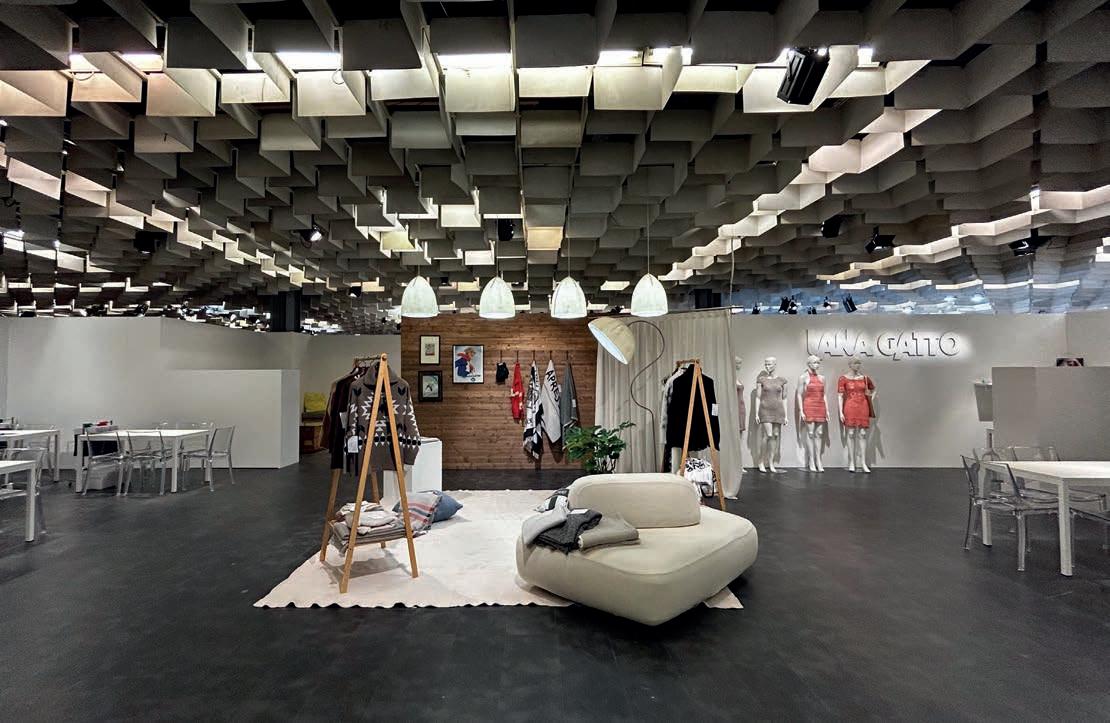
The Harmony4.0 and Harmony yarns, strengthened by its performance qualities such as creaseability and stain-resistance, softness and aesthetics, were used to dress furniture and accessories that enliven home environments, giving ever-new suggestions.

Used to upholster knitted sofa seats, hats of hanging or floor lamps, plaids, blankets and rugs, wool has become an interpreter of homedress, designing new looks capable of re-

aziende fortemente innovative, sia artigiani che, con il loro solido Know How, sono interpreti del migliore “Made in Italy”: Art Nova, In-Es ArtDesign , Artigiani del Cashmere e Alessandrosimoni cashmere, Pool Trend e Casalegno Tendaggi.
english text
newing the image of rooms with simplicity but preciosity, generating well-being in the environments in which it is found.
In fact, an experiment conducted in Great Britain by the Electricity Council's Research Center confirmed that, in a room saturated with moisture and then sealed, the presence of wool-covered floors and furnishing fabrics in the same yarn helped reduce humidity considerably within a few hours.
Having believed in the "TOLLEGNO 1900 BLANKET DRESSING" Project, using Harmony 4.0 to produce accessories used to furnish part of the brand's booth at Pitti Immagini Filati 93, were both highly innovative companies and artisans who, with their solid Know How, are interpreters of the best "Made in Italy": Art Nova, In-Es ArtDesign, Artigiani del Cashmere and Alessandrosimoni cashmere, Pool Trend and Casalegno Tendaggi.

textures 55
writer Pietro Ferrari www.micspa.com
MILLE VARIANTI E MILLE COLORI
MIC s.p.a., Manifattura Italiana Cucirini, è ospite a Pitti Immagine Filati, nello stand di Shima Seiki Italia: la collaborazione tra il produttore veneto di filo e il leader tecnologico giapponese viene ben espressa in questo stand che è una festa di stile ed eleganza,

insieme a tecnologia e materiali innovativi.
È a Tommaso Cumerlato, Chief Sales Officer di MIC, che chiediamo di raccontarci come è nata la collaborazione con Shima Seiki.
«Ad un evento passato di Shima Seiki – ci dice – ab-
biamo incontrato Vittorio Branchizio, uno stilista ben conosciuto che già al tempo aveva fatto propria missione quella di informare gli utilizzatori delle macchine da maglieria delle potenzialità di tali tecnologie, unite all’utilizzo di diversi materiali. Vittorio, fin da quando lo abbiamo conosciuto, opera con una forte passione per lo sviluppo di prodotto e con una spinta verso l’abbattimento delle barriere di una maglieria già conosciuta, per andare oltre l’utilizzo dei soli cashmere e cotone, e per far questo ha dovuto trovare un’alternativa alle filature monoprodotto, trovando in MIC un vero e proprio "parco giochi" di titoli, colori e materie prime. L’assenza di minimi d’ordine per la nostra gamma colori è una qualità che l’art director ha apprezzato molto, soprattutto nelle fasi di campionatura e test sulle macchine Shima Seiki, potendo realizzare al meglio i propri campioni e le diverse sfumature degradé –un espediente cromatico tipico della maglieria.
issue034
textures 56 AREAMAGLIERIAMIC MANIFATTURA ITALIANA CUCIRINI CONTINUA LA COLLABORAZIONE CREATIVA E TECNOLOGICA TRA MIC MANIFATTURA ITALIANA CUCIRINI E SHIMA SEIKI
Tommaso Cumerlato di MIC e lo stilista Vittorio Branchizio nello stand Shima Seiki a Pitti Filati giugno.
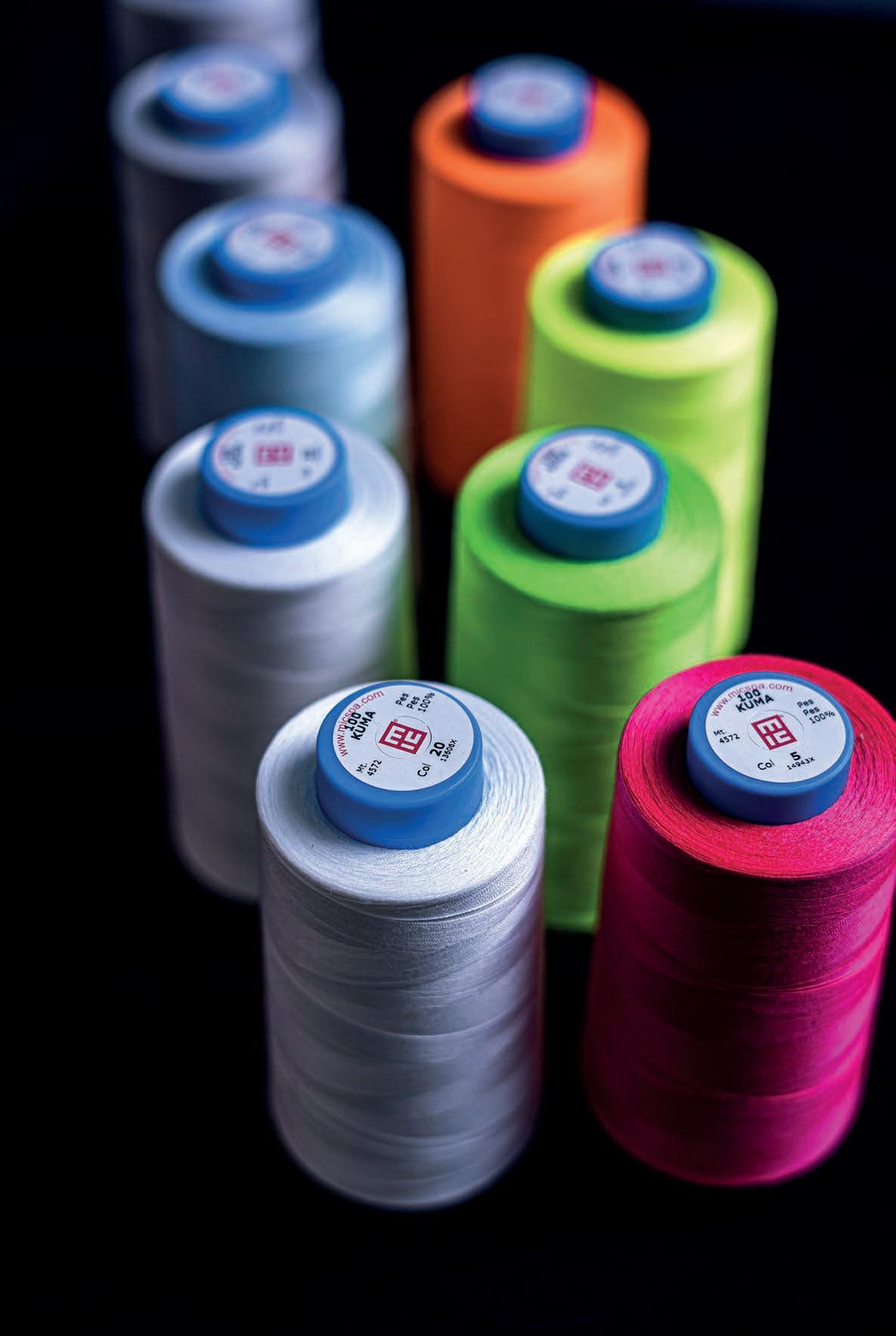
textures 57
Fantasie illimitate nei coni colore.
AREAMAGLIERIAMIC MANIFATTURA ITALIANA CUCIRINI
A seconda del prodotto ci vengono richiesti filati di diversa materia prima ed origine, dal cotone al poliestere e poliammide, fino a elastomeri e mischie di queste fibre. Exté è uno di questi filati: ideale per realizzare capi compatti ed ergonomici, flessuosi e strutturati assieme: l’utilizzo dell’elastomero, a seconda delle tensioni e percentuali d’utilizzo, può creare un tessuto fittissimo, o rendere possibile una mano compatta ma morbida».
PIETRO FERRARI – State facendo un percorso di ricerca parallelo?
TOMMASO CUMERLATO –
Direi quasi simbiotica: scopriamo delle nuove applicazioni per i nostri prodotti e Vittorio può avere soddisfazione nelle risposte alle sue esigenze: è una sinergia.
PIETRO FERRARI – Questo si inserisce in una tradizione MIC di ricerca?
TOMMASO CUMERLATO –
Noi nasciamo ormai 45 anni fa con la produzione di acces-
sori per la confezione tra cui filo da cucire, ai tempi di mio padre e mio zio (commerciale e tecnico rispettivamente)
c’erano moltissimi cluster di rilievo, in particolare in Veneto: lavorando con questi leader ti abitui a diversificare e fare le cose veloci, siamo entrati in
THE CREATIVE AND TECHNOLOGICAL COLLABORATION BETWEEN MIC MANIFATTURA ITALIANA CUCIRINI AND SHIMA SEIKI CONTINUES
MIC s.p.a., Manifattura Italiana Cucirini, is a guest at Pitti Immagine Filati, in the Shima Seiki Italia stand: the collaboration between the Venetian thread manufacturer and the Japanese technological leader is well expressed in this stand which is a celebration of style and elegance, together with innovative technology and materials.
We ask Tommaso Cumerlato, Chief Sales Officer of MIC, to tell us how the collaboration with Shima Seiki was born.
"At a past Shima Seiki event – he tells us – we met Vittorio Branchizio, a well-known stylist who at the time had already made it his mission to inform knitting machine users of the potential of these technologies, combined with the use of different materials. Ever since we met him, Vittorio

questo mondo grazie alla disponibilità di tanti colori e piccole quantità consegnate al volo. Il cliente per noi è particolarmente gradito se vuole velocità e lotti ridotti. Le nostre ultime novità lanciate sul mercato sono il già citato Exte 2.7 Soft, mentre nel mondo cucirino abbiamo presentato il filato riciclato Golden GRS: filo dall’alta resistenza, molto pulito, opaco e low-hairiness. Attraverso una procedura termoplastica riusciamo a limitarne la pelosità, richiesta nel vasto mondo dell’abbigliamento di qualità dove c'è bisogno di filati sottili, ma puliti. Il processo di creazione di questo articolo ha richiesto di seguire i protocolli e le certificazioni più stringenti in termini di chimica e materiali.”
"Qui a Pitti ci siamo inseriti nella presentazione della nuova capsule collection: The Orbit – ci dice Nicola Carletti, marketing manager di MIC –in collaborazione con Vittorio Branchizio e Shima Seiki.
has been working with a strong passion for product development and with a drive towards breaking down the barriers of an already known knitwear, to go beyond the use of cashmere and cotton alone, and to do this he had to find an alternative to spinning single product, finding in MIC a real "playground" of counts, colors and raw materials. The absence of minimum orders for our color range is a quality that the art director greatly appreciated, especially in the sampling and testing phases on Shima Seiki machines, being able to create his own samples and the various degradé shades in the best possible way – a chromatic expedient typical of knitwear. Depending on the product, we are asked for yarns of different raw materials and origins, from cotton to polyester and polyamide, up to elastomers and blends of these fibres.
Exté is one of these yarns: ideal for making compact and ergonomic garments, supple and structured at the same time: the use of elastomer, depending on the tensions and
issue034 www.micspa.com textures 58
english text
Nello specifico, in questa collezione è stato utilizzato Exté 2.7 Soft, filato elastico made in italy, sulle diverse macchine per diversi utilizzi tecnici e stilistici: l’elastico è alla base di queste nuove lavorazioni, come ad esempio compattare le maglie dei capi, unire diversi tessuti in double oppure creare disegni ben definiti.
Possiamo vedere che nello stand ci sono dieci capi in esposizione, ed in più della metà, è stato utilizzato Exté. In una fila è stato utilizzato Extè per donare ai capi compattezza ed ergonomicità, creando tessuti che abbracciano il corpo ma nel contempo permettono un rientro alla forma originaria anche dopo diversi utilizzi e lavaggi, questo perché Exté si inserisce all’interno dei punti della maglia, creando un’armatura elastica e compatta.
Oltre all’elastico, in questa collezione, all’interno dello Jacquard Suit a maglia strappata è stato utilizzato, misto a diverse lane, un altro filato MIC, tipico del mondo del denim, caratterizzato da un'anima di poliestere ricoperta in cotone: Polidenim. La speciale tintura del cotone di questo filato, sbiadisce nei lavaggi riproponendo un effetto denim vintage, opaco e leggermente melange. L’utilizzo del cotone misto lana, crea differenze nella percezione della brillantezza del colore, nonché al tatto quando indossato: il cotone infatti è recepito a contatto con la pelle come più fresco rispetto alla lana.
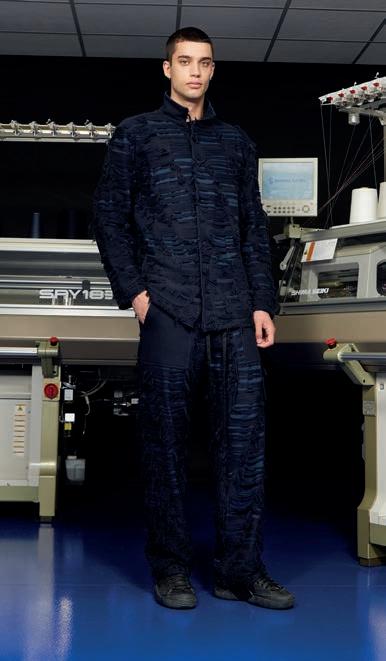
Un altro capo distintivo della collezione è un capo wholegarment a 4 capi, 3 in cashmere sullo stesso tono ma in tre gradazioni differenti più 1
capo di Exté 2.7 in tono. Questo capo è stato denominato Origami Dress 2.0, in quanto evoluzione di un capo di Vittorio Branchizio, che in questa capsule è contraddistinto da un parallelepipedo tridimensionale ripetuto lungo tutta la lunghezza del capo - più delicato e ridotto in prossimità del collo, sempre più marcato e definito verso il fondo; questo è reso possibile dal sapiente utilizzo dei colori in fase di design e dell’elastomero per dare il corretto e preciso tiraggio nell’intero capo.
L’effetto finale in 3D è di grande impatto, soprattutto considerando l’utilizzo della tecnica wholegarment, che consiste nella programmazione del macchinario in modo che il capo esca dalla macchina in un’unica soluzione, senza successiva necessità di rimagli, ma pronto per lavaggi e finissaggi che non richiedono ulteriori interventi di macchinari di produzione knitwear.
Tecnologia e creatività.
La programmazione dei macchinari Shima Seiki Italia si è evoluta negli ultimi anni ed oggi utilizza un sistema dedicato, denominato Apex, che permette la digitalizzazione di tutto il processo di definizione del modello, del disegno, delle tecniche che si desiderano utilizzare in produzione, visualizzando in tempo reale sullo schermo l’effetto finale della vestibilità del capo, tessuto e colore su un manichino digitale.
Questa metodologia permette non solo un’eccellente definizione dei dettagli, ma anche un risparmio di materiali e avvii macchina in fase di campionatura: con un sapiente programmatore e art director si può ottenere il prototipo definitivo al primo colpo».
Il commento di chiusura è di Vittorio Branchizio , direttore creativo Shima Seiki Italia: «Con MIC sono tre anni circa di forte collaborazione e sinergia per creare dei filati che possano servire alla maglieria e quindi utilizzabili su macchine rettilinee o whole garment; in questa stagione abbiamo utilizzato l’Exté su varie soluzioni, serve per me per compattare la struttura con elastomero in tinta. Il servizio colori è fondamentale nella maglieria per abbinare i toni verso un giusto risultato estetico e compattare una struttura molto leggera tramite l’elastomero, ottenendo leggerezza e compattezza assieme... e questo è solo l’inizio».
textures 59
percentages of use, can create a very dense fabric, or make possible a compact but soft hand."
PIETRO FERRARI – Are you following a parallel research path?
TOMMASO CUMERLATO – I would say almost symbiotic: we discover new applications for our products and Vittorio can be satisfied with the answers to his needs: it is a synergy.
PIETRO FERRARI – Does this fit into a MIC tradition of research?
TOMMASO CUMERLATO – We were born 45 years ago with the production of accessories for garment making including sewing thread, in the time of my father and my uncle (commercial and technical respectively) there were many important clusters, especially in Veneto: working with these leaders you get used to diversifying and doing things quickly, we entered this world thanks to the availability of many colors and small quantities delivered on the fly. For us, the customer is particularly welcome if he wants speed and small batches.
Our latest novelties launched on the market are the aforementioned Exte 2.7 Soft, while in the sewing world we have presented the Golden GRS recycled yarn: highstrength, very clean, opaque and low-hairiness thread. Through a thermoplastic procedure we are able to limit the hairiness, required in the vast world of quality clothing where there is a need for thin but clean yarns. The process of creating this article required following the most stringent protocols and certifications in terms of chemistry and materials.”
"Here at Pitti we took part in the presentation of the new capsule collection: The Orbit - says Nicola Carletti, marketing manager of MIC - in collaboration with Vittorio Branchizio and Shima Seiki. Specifically, in this collection Exté 2.7 Soft, an elastic yarn made in Italy, was used on the different machines for different technical and stylistic uses: the elastic is the basis of these new processes, such as for example compacting the garments' shirts, joining different fabrics in doubles or creating well-defined designs. We can see that there are ten garments on display in the stand, and in more than half, Exté has been used. Extè was used in one row to give the garments compactness and ergonomics, creating fabrics that hug the body but at the same time allow them to return to their original shape even after several uses and washings, this because Exté fits inside the stitches of the shirt, creating an elastic and compact weave.
In addition to the elastic, in this collection, another MIC yarn, typical of the world of denim, has been used mixed with various wools inside the torn-knit Jacquard Suit, characterized by a polyester core covered in cotton: Polidenim. The special cotton dyeing of this yarn fades in washing, proposing a vintage, opaque and slightly melange denim
effect. The use of wool-blend cotton creates differences in the perception of color brilliance, as well as to the touch when worn: in fact, cotton is perceived in contact with the skin as cooler than wool.
Another distinctive item of the collection is a 4-ply wholegarment item, 3 in cashmere in the same tone but in three different shades plus 1 item in Exté 2.7 in tone. This garment has been called Origami Dress 2.0, as an evolution of a Vittorio Branchizio garment, which in this capsule is characterized by a three-dimensional parallelepiped repeated along the entire length of the garment - more delicate and reduced near the neck, increasingly marked and defined towards the bottom; this is made possible by the skilful use of colors in the design phase and of the elastomer to give the correct and precise draft throughout the garment. The final 3D effect is of great impact, especially considering the use of the wholegarment technique, which consists in programming the machinery so that the garment comes out of the machine in a single solution, without the subsequent need for linking, but ready for washing and finishing which do not require further interventions by knitwear production machinery.
The programming of Shima Seiki Italia machinery has evolved in recent years and today uses a dedicated system, called Apex, which allows the digitization of the entire process of defining the model, the design, the techniques to be used in production, displaying in real time on the screen the final effect of the fit of the garment, fabric and color on a digital mannequin. This methodology allows not only an excellent definition of the details, but also a saving of materials and machine start-ups in the sampling phase: with a skilful programmer and art director, the definitive prototype can be obtained right away.
The closing comment is from Vittorio Branchizio, creative director of Shima Seiki Italia: "With MIC it has been about three years of strong collaboration and synergy to create yarns that can be used for knitwear and therefore usable on straight-line machines or whole garments; this season we have used Exté on various solutions, it is used for me to compact the structure with a matching elastomer. The color service is essential in knitwear to combine tones towards the right aesthetic result and compact a very light structure using the elastomer, obtaining lightness and compactness together... and this is just the beginning."
issue034 www.micspa.com textures 60 AREAMAGLIERIAMIC MANIFATTURA ITALIANA CUCIRINI
SUCCESSO IMMEDIATO PER ACTIVE EVOLVE
PrimaLoft, leader globale nelle tecnologie dei materiali d’avanguardia, rafforza la gamma Active, con le proposte Active Evolve rivoluzionario tessuto isolante che si adatta a moltissime attività, molteplici situazioni, infinite performance. Le ragioni del nuovo successo stanno nella perfetta traspirabilità in ogni caso, nella perfetta gestione dell’umidità ed elasticità qualunque sia l’intensità dell’azione e la stagione e nella sua sostenibilità.
PrimaLoft, Inc., sta riscontrando anche in Italia entusiasmo e successi significativi per l’isolamento Active Evolve, linea innovativa che unisce eccezionale traspirabilità, superiore gestione dell’umidità a grandi doti di elasticità.
«È una formula molto avanzata e intelligente” sottolineano i grandi marchi internazionali dell’outdoor e del lifestyle – così come gli utilizzatori più esigenti – ora possiamo ridurre il numero di capi da utilizzare e nel medesimo tempo avere le stesse preziose caratteristiche di comfort, qualità e performance dei vari modelli, quale sia la stagione e l’intensità dell’azione».
QUATTRO SOLUZIONI INNOVATIVE
Proprio per rispondere a queste sofisticate necessità PrimaLoft ha realizzato ben quattro nuove soluzioni innovative Active Evolve.
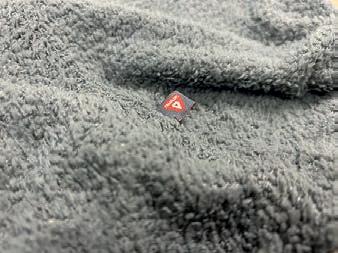

Active Evolve è una linea di tessuti isolanti PrimaLoft progettata per elevare prestazioni, sostenibilità e design.
Combinando il calore leggero dell'isolamento con la traspirabilità del tessuto, questa tecnologia è ideale per molteplici attività indipendentemente dall'intensità d’uso o dalla stagione. Dallo spingersi sugli sci di fondo al sudare in un'escursione verso la nova vetta Active Evolve mantiene tutti nella
propria comfort zone, anche quando si vorrebbe andare oltre. Diversi prodotti della linea Active Evolve possono essere utilizzati come tessuti next to skin. Ciò consente ai produttori di rinunciare alle fodere, poiché calore e l'umidità sono gestiti in modo più efficiente, la traspirabilità è supportata e il comfort dell'utente rimane elevato.
Oltre a mantenere prestazioni ottimali durante l'attività aerobica, Active Evolve permette un utilizzo più ampio e per l’intero anno: caratteristiche, queste, che consentono alle aziende una diversa progettazione con minori materiali complessivi, minori ingombri, pesi e sprechi.
PrimaLoft Active Evolve offre numerosi vantaggi ai progettisti. Consente loro di utilizzare l'intero spettro di colori, incorporare motivi unici, offrire una maggiore flessibilità nella selezione del tessuto, eliminare la necessità di trapuntatura.
Sostenibilità: ben tre dei quattro nuovi Active Evolve sono realizzati con contenuto riciclato al 100% post consumo. «Questa serie di prodotti è stata progettata per evolversi con te», afferma Tara Maurer-
textures 61 issue034
Redazione https://primaloft.com TESSUTOTECNICO PRIMALOFT
writer
L'AMPLIAMENTO DI
DI ACTIVE DI PRIMALOFT SI ARRICCHISCE DI NUOVE PROPOSTE.
GAMMA
Mackay, Senior Vicepresident per la strategia di prodotto in PrimaLoft. «La traspirabilità di Active Evolve fornisce un sistema di termoregolazione che mantiene il comfort ed eleva le prestazioni per qualsiasi attività, durante tutto l’anno».
Lo scorso inverno, Sitka ha presentato Active Evolve nella sua collezione Ambient, abbigliamento tecnico da caccia.
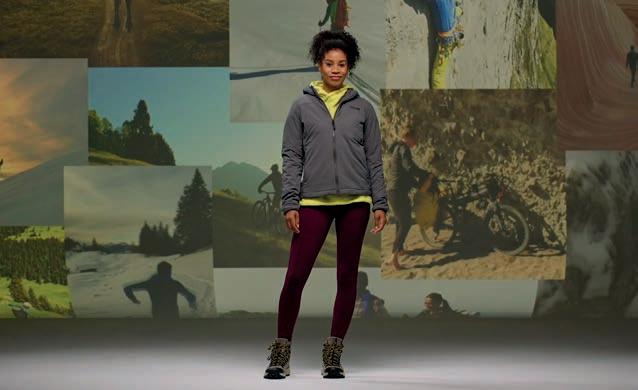
Per lo sviluppo dei suoi tre modelli di giacca Ambient, uomo e donna, i progettisti di Sitka hanno dovuto trovare un isolamento che fosse durevole, comprimibile e, soprattutto, adattabile alle mutevoli condizioni meteorologiche e ai livelli di attività.
«La collezione Ambient di SITKA con PrimaLoft Active Evolve è una proposta che funziona molto bene in una vasta gamma di attività» afferma
John Barklow, Senior Product Line Manager di SITKA.
«Questi capi sono altamente traspiranti durante l'attività aerobica e forniscono un calore adeguato una volta che hai rallentato il ritmo. La giacca e la felpa con cappuccio Ambient sono fatte per muoversi con te e offrire comfort in una varietà di intervalli di temperatura e livelli di attività».
Lo specialista degli sport di endurance Loeffler integrerà Pri-
maLoft® Active Evolve nella sua collezione sci da fondo per questa stagione invernale. Il marchio austriaco è noto per i suoi capi di abbigliamento di alta qualità, che uniscono responsabilità e innovazione. Nella veste di partner ufficiale per l'abbigliamento delle squadre austriache di sci nordico, i capi Loeffler devono funzionare al massimo livello.
«Active Evolve è particolarmente adatto per l'abbigliamento sportivo di altissimo livello dove si richiede un isolamento versatile», ha affermato Stefan Gögele, responsabile gestione prodotti presso Loeffler. «Questo prodotto offre la combinazione perfetta di traspirabilità, trasporto dell'umidità e prestazioni termiche. Allo stesso tempo, è meravigliosamente comprimibile e sostenibile poiché utilizza contenuto riciclato, fatto che. lo rende un partner ideale per le nostre giacche da sci di fondo, ciclismo e scialpinismo».
A PROPOSITO DI PRIMALOFT
PrimaLoft, Inc. è una società di scienza dei materiali d’avanguardia con sede a Latham, New York, e uffici a Xiamen, in Cina. PrimaLoft è leader mondiale nella ricerca e sviluppo
di soluzioni innovative per il comfort basate su materiali per l’isolamento e tessuti ad alte prestazioni. L'isolamento PrimaLoft® è stato originariamente sviluppato per l'esercito degli Stati Uniti come alternativa sintetica al piumino resistente all'acqua. alla piuma d’oca, ma resistente all’acqua. Dal 1983, un patrimonio di tecnologie comprovate e testate ha creato fiducia nell'industria tessile, con oltre 950 marchi globali che utilizzano i prodotti PrimaLoft per l'outdoor, la moda, l'arredamento per la casa, l'abbigliamento da lavoro, caccia e applicazioni militari. Con la sua missione Relentlessly Responsible™, PrimaLoft si sforza di bilanciare innovazione, prestazioni e sostenibilità nella ricerca di un futuro migliore. Oggi, il marchio è riconosciuto come un punto di riferimento che fornisce comfort insuperabile in qualsiasi condizione, riducendo al contempo il suo impatto sull'ambiente. PrimaLoft è attiva nella produzione tessile sostenibile attraverso partnership con il sistema bluesign®, l'International OEKO-TEX® Association, l'Higg Index della Sustainable Apparel Coalition e il Global Recycled Standard. PrimaLoft, Inc. è una controllata di Compass Diversified (NYSE: CODI).

issue034 https://primaloft.com textures 62
TESSUTOTECNICO PRIMALOFT
THE EXPANSION OF THE PRIMALOFT ACTIVE RANGE IS ENHANCED BY NEW PROPOSALS
PrimaLoft, global leader in cutting-edge material technologies, strengthens the Active range, with the Active Evolve proposals, a revolutionary insulating fabric that adapts to many activities, multiple situations, infinite performances. The reasons for the new success lie in the perfect breathability in any case, in the perfect management of humidity and elasticity whatever the intensity of the action and the season and in its sustainability.
PrimaLoft, Inc. is also experiencing enthusiasm and significant successes in Italy for Active Evolve insulation, an innovative line that combines exceptional breathability, superior moisture management with great elasticity.
"It's a very advanced and intelligent formula" underline the major international outdoor and lifestyle brands – as well as the most demanding users – now we can reduce the number of garments to use and at the same time have the same precious comfort features, quality and performance of the various models, whatever the season and the intensity of the action”.
FOUR INNOVATIVE SOLUTIONS
Precisely to respond to these sophisticated needs, PrimaLoft has created four new innovative Active Evolve solutions. Active Evolve is a line of PrimaLoft insulating fabrics designed to elevate performance, sustainability and design. Combining the lightweight warmth of insulation with the breathability of fabric, this technology is ideal for multiple activities - regardless of intensity of use or season. From pushing yourself on cross-country skis to sweating on a hike to the new summit, Active Evolve keeps everyone in their comfort zone, even when they want to go further. Several products from the Active Evolve line can be used as next to skin fabrics. This allows manufacturers to do without linings, as heat and moisture are managed more efficiently, breathability is supported and user comfort remains high. In addition to maintaining optimal performance during aerobic activity, Active Evolve allows for wider use throughout the year: these characteristics allow companies to design differently with fewer overall materials, smaller dimensions, weight and waste.
PrimaLoft Active Evolve offers numerous benefits to designers. It allows them to use the full color spectrum, incorporate unique patterns, offer greater flexibility in fabric selection, eliminate the need for quilting.
Sustainability: three of the four new Active Evolve are made with 100% post-consumer recycled content.
“This product series is designed to evolve with you,” says Tara Maurer-Mackay, Senior Vice President of Product Strategy at PrimaLoft. "Active Evolve's breathability provides a thermoregulation system that maintains comfort and
elevates performance for any activity, all year round."
Last winter, Sitka introduced Active Evolve in its Ambient collection, technical hunting clothing. To develop its three men's and women's Ambient jacket models, Sitka's designers had to find insulation that was durable, compressible and, most importantly, adaptable to changing weather conditions and activity levels.
“SITKA's Ambient collection with PrimaLoft Active Evolve is a proposition that works very well across a wide range of activities,” says John Barklow, Senior Product Line Manager at SITKA.
“These pieces are highly breathable during aerobic activity and provide adequate warmth once you slow down the pace. The Ambient Jacket and Hoodie are made to move with you and provide comfort across a variety of temperature ranges and activity levels."
Endurance sports specialist Loeffler will integrate PrimaLoft® Active Evolve into its cross-country ski collection this winter season. The Austrian brand is known for its high-quality clothing, which combines responsibility and innovation. As the official clothing partner of the Austrian Nordic ski teams, Loeffler clothing must perform at the highest level.
“Active Evolve is particularly suitable for top-level sportswear where versatile insulation is required,” said Stefan Gögele, head of product management at Loeffler. “This product offers the perfect combination of breathability, moisture transport and thermal performance. At the same time, it's wonderfully packable and sustainable as it uses recycled content, which is a fact. makes it an ideal partner for our cross-country, cycling and ski touring jackets.”
ABOUT PRIMALOFT
PrimaLoft, Inc. is a pioneering materials science company headquartered in Latham, New York, with offices in Xiamen, China. PrimaLoft is a world leader in the research and development of innovative comfort solutions based on insulation materials and high performance fabrics. PrimaLoft® insulation was originally developed for the US military as a synthetic alternative to water-resistant down. goose down, yet water resistant. Since 1983, a heritage of tried and tested technologies has built trust in the textile industry, with over 950 global brands using PrimaLoft products for outdoor, fashion, home furnishings, workwear, hunting and military applications. With its Relentlessly Responsible™ mission, PrimaLoft strives to balance innovation, performance and sustainability in the pursuit of a better future. Today, the brand is recognized as a benchmark that provides unsurpassed comfort in all conditions, while reducing its impact on the environment. PrimaLoft is active in sustainable textile production through partnerships with the bluesign® system, the International OEKO-TEX® Association, the Higg Index of the Sustainable Apparel Coalition and the Global Recycled Standard. PrimaLoft, Inc. is a subsidiary of Compass Diversified (NYSE: CODI).
textures 63
english text
writer Beatrice Guidi https://tech-now.ch
TECHNOW: OLTRE LA FORNITURA DEL TESSUTO TECNICO
Abbiamo chiesto a Francesco Lazzati, direttore di Technow SA, azienda svizzera che si occupa di sviluppo, produzione e commercializzazione di tessuti tecnici per moda e sportswear, di farci una fotografia della situazione attuale.
Francesco, come sta evolvendo il business per le aziende fornitrici di tessuti? Quello che stiamo vivendo negli ultimi anni, soprattutto dopo l’emergenza Covid, è una piccola ma significativa rivoluzione. Chi, come Technow, produce e commercializza tessuti, vede quotidianamente una crescente domanda che non si esaurisce con la richiesta del mero tessuto. I clienti chiedono sempre di più, a noi fornitori, un supporto in termini di consulenza e servizi. La sola fornitura in sé e per sé non è più
COSA CERCA OGGI UN CLIENTE DA UN FORNITORE DI TESSUTI? QUALI SONO OGGI LE SUE ASPETTATIVE? BANALE, DIRETE VOI: VUOLE UN TESSUTO. LA RI- SPOSTA REALE, INVECE, COSÌ BANALE NON È. NON PIÙ, QUANTOMENO. CERCHIAMO DUNQUE DI CAPIRE COME STA EVOLVENDO IL MERCATO E COME STANNO CAMBIANDO LE SUE DOMANDE: SE IN PASSATO AL “TESSUTAIO” VENIVANO FATTE RICHIESTE ESCLUSIVAMENTE IN TERMINI DI COLORI, METRI, COMPOSIZIONI E DATE DI CONSEGNA, OGGI NON È PIÙ COSÌ.

issue034
textures 64 TESSUTOTECNICOTECHNOW
Una foto del team Technow Switzerland (da sinistra Fabio Lazzati, Veronica Lazzati, Francesco Lazzati e Roberta Pagnetti).
TECHNOW: BEYOND THE SUPPLY OF TECHNICAL FABRIC
What is a customer looking for from a fabric supplier today? What are your expectations today? Trivial, you say: he wants a fabric.
The real answer, however, is not so trivial. Not anymore, at least.
So, let's try to understand how the market is evolving and how its demands are changing: if in the past requests were made to the "fabric maker" exclusively in terms of colors, meters, compositions and delivery dates, today this is no longer the case.
We asked Francesco Lazzati, director of Technow SA, a Swiss company that deals with the development, production and marketing of technical fabrics for fashion and sportswear, to give us a picture of the current situation.
Francesco, how is the business evolving for fabric supplier companies?
What we have been experiencing in recent years, especially after the Covid emergency, is a small but significant revolution. Those who, like Technow, produce and market fabrics, see a growing demand every day that does not end with the demand for mere fabric. Customers are increasingly asking us suppliers for support in terms of consultancy and services. Supply alone in and of itself is no longer sufficient to meet the market demand.
What do customers expect today from those who produce fabrics?

They expect a full service. They expect to be followed and advised at all stages of the supply chain. It starts from the request for the fabric, obviously, but it also needs to be accompanied in the pre- and post-sales services. Most of the time the fabric is created ad hoc following repeated comparisons between the parties: the customer in fact wants to know the performance and quality controls carried out, wants to have information on the sustainability of its production and increasingly also requests contextualisations of the fabric in a finished garment. This need to imagine the yield in the final garment needs further support in terms of research and development. The customer essentially seeks, in a single interlocutor, to be accompanied along the entire supply chain.
In practical terms, how is this scenario changing your work?
A: An important challenge is underway for us. We have intercepted the change and are now structuring ourselves to manage it. It is no coincidence that in our recent rebranding we have also adjusted the brand promise: from technical textile generation to next textile generation. We are moving rapidly towards a complete offer: we are and remain "weavers", but soon we will also develop the finished garment for our customers.
A real leap into the next textile generation, with an offer of services at 360 degrees.
textures 65 english text
Dettaglio di un telaio ad acqua.
TESSUTOTECNICOTECHNOW
https://tech-now.ch
sufficiente a soddisfare la domanda del mercato.

Cosa si aspetta oggi un cliente, da chi produce tessuti?
Si aspetta un servizio completo. Si aspetta di essere seguito e consigliato in tutte le fasi della filiera di approvvigionamento. Parte dalla richiesta del tessuto, è chiaro, ma ha necessità di essere accompagnato anche nei servizi di pre e post-vendita.
Il più delle volte il tessuto viene creato ad hoc in seguito a ripetuti confronti tra le parti: il cliente vuole infatti conoscere le performance e i controlli qualità effettuati, vuole avere informazioni sulla sostenibilità della sua produzione e sempre

In alto: Orditoio.
Al centro: esempi di tessuti Technow.
A destra: un capo finito.
issue034
textures 66
più spesso richiede anche contestualizzazioni del tessuto in un capo finito. Questa necessità di immaginare la resa nel capo finale necessita di ulte-
riore supporto in termini di ricerca e sviluppo. Il cliente cerca sostanzialmente, in un unico interlocutore, di essere accompagnato lungo tutta la filiera.
In termini pratici questo come sta cambiando il vostro lavoro?
Per noi è in corso una sfida importante. Abbiamo intercettato il cambiamento e ora ci stiamo strutturando per gestirlo. Non è un caso che nel nostro recente rebranding abbiamo adeguato anche la promessa di marca: da technical textile generation a next textile generation. Ci stiamo muovendo a passi rapidi verso un’offerta completa: siamo e restiamo “tessutai”, ma presto arriveremo a sviluppare anche il capo finito per i nostri clienti. Un vero e proprio salto nella prossima generazione tessile, con un’offerta di servizi a 360 gradi.



textures 67
STAMPA TESSILE DIGITALE: CAPACITÀNUOVE PRODUTTIVE

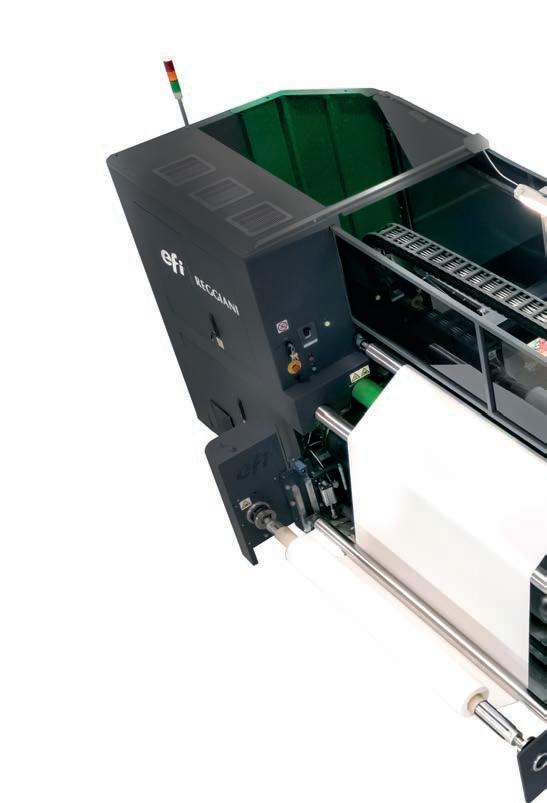
Tra i prodotti presentati, EFI Reggiani ecoTERRA è una soluzione all-in-one per la stampa a pigmenti a base d’acqua che non richiede attrezzature ausiliarie per il pre e post-trattamento. Riducendo significativamente il consumo di acqua, energia e sostanze chimiche nel processo complessivo, i clienti possono ora ottenere una soluzione di stampa diretta su tessuto realmente sostenibile.
Gli inchiostri a pigmenti a base d’acqua ecoTERRA offrono eccellenti proprietà di solidità a secco e a umido,
un’incredibile nitidezza dei dettagli e un’eccezionale durata, garantendo al contempo la longevità della testina di stampa con costi di manutenzione ridotti. Grazie alla nuova unità di polimerizzazione e finitura, EFI Reggiani ecoTERRA offre anche un’esperienza tattile e una morbidezza del tes suto migliori rispetto ai prece denti risultati di stampa a pigmento.
tata in ITMA è EFI Reggiani HYPER, la stampante tessile digitale a scansione più veloce del mercato, in grado di offrire una qualità di stampa straordinaria con una produttività senza pari.
issue034
textures 68 AREATECNOLOGIEEFI™ REGGIANI A ITMA
E
writer Beatrice Guidi www.efi.com/reggiani
2023 EFI™ REGGIANI HA PRESENTATO SOLUZIONI TESSILI INNOVATIVE CHE OFFRONO VANTAGGI IN TERMINI DI SOSTENIBILITÀ
FLUSSO DI LAVORO DIGITALE ON-DEMAND.
Dotata di 72 testine di stampa e di ricircolo dell'inchiostro fino al piatto ugelli, è in grado
di attività e affidabilità poten ziati, prestazioni elevate in ogni fase, precisione di stampa senza pari e necessità di manutenzione minime, che si può considerare un vero e
proprio sostituto digitale della stampa rotativa.
Infine, ITMA ha visto il lancio anche EFI Reggiani , lo strumento di analisi dei dati avanzato, grazie al quale si possono misurare le prestazioni della stampante, oltre a tenere traccia dei costi reali per metro e monitorare il consumo di acqua ed energia; e del nuovo EFI Reggiani end-to-end workflow, che con l’integrazione di Inèdit, aumenta la produttività e le capacità di produzione per le operazioni di stampa tessile digitale, garantendo al contempo la massima sicurezza per i progetti del cliente grazie alla crittografia
EFI™ è un'azienda tecnologica globale che è in grado di supportare i professionisti della stampa nella transizione dall'analogico al digitale, offrendo strumenti, prodotti, soluzioni, formazione, servizio e assistenza, durante il loro percorso verso il digitale.


textures 69
DIGITAL TEXTILE PRINTING: NEW PRODUCTION CAPABILITIES
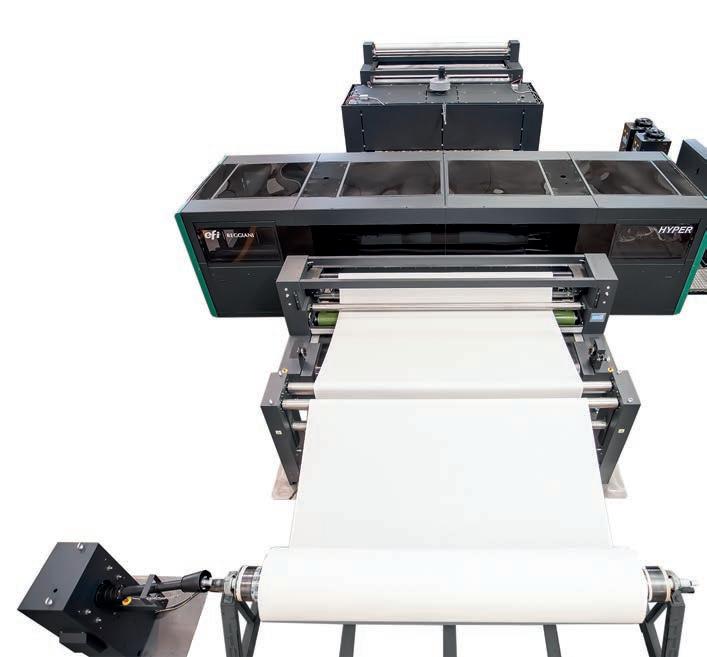
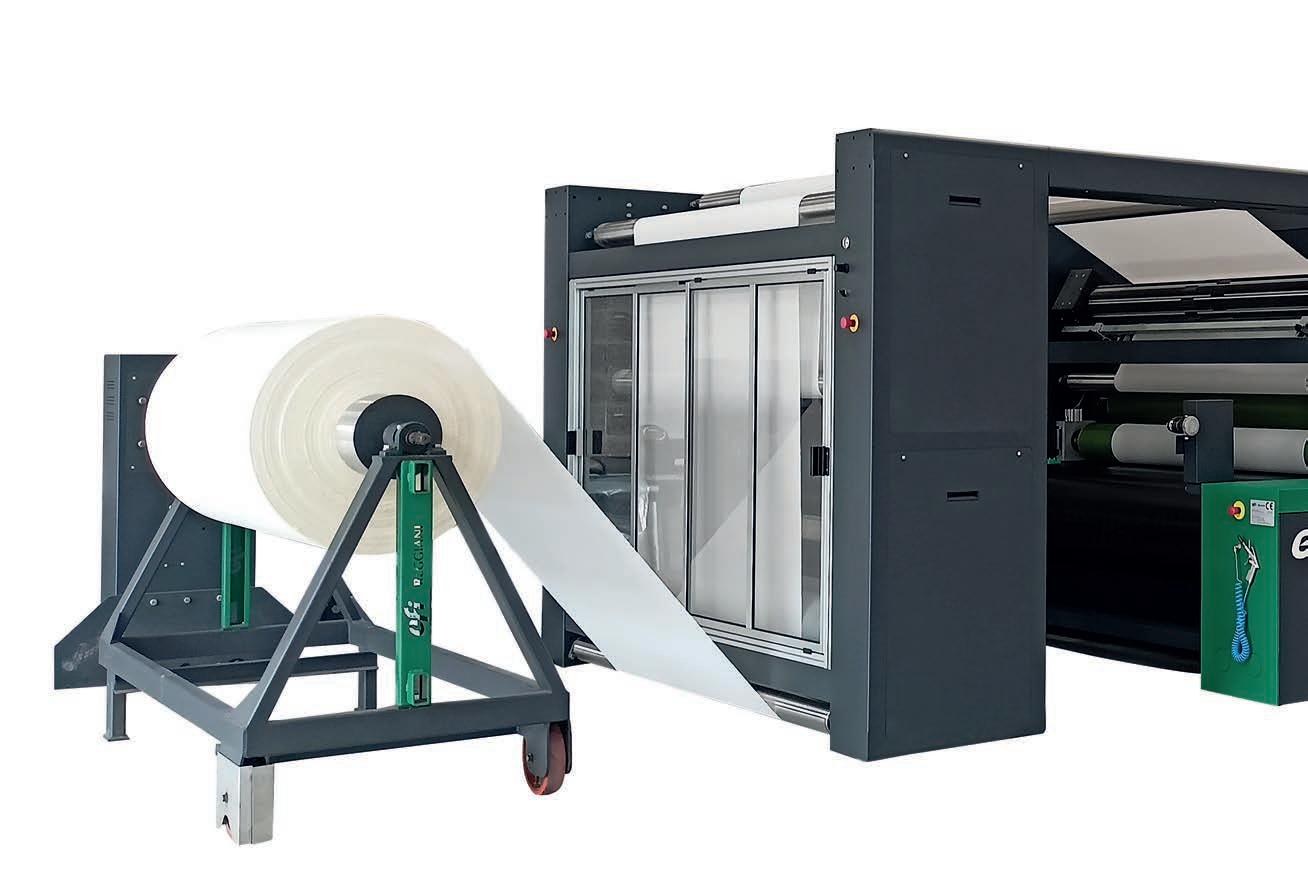
AT ITMA 2023, EFI™ REGGIANI PRESENTED INNOVATIVE TEXTILE SOLUTIONS THAT OFFER SUSTAINABILITY BENEFITS AND ON-DEMAND DIGITAL WORKFLOW.
First of all, the EFI Reggiani ecoTERRA solution is an all-inone solution for water-based pigment printing that requires no auxiliary equipment for pre- and post-treatment. By significantly reducing the consumption of water, energy and chemicals in the overall process, customers can now achieve a truly sustainable direct-to-fabric printing solution. Reggiani ecoTERRA water-based pigment inks offer excellent wet and dry fastness properties, incredible detail sharpness and exceptional durability, while ensuring printhead longevity with reduced maintenance costs. With an enhanced curing and finishing unit, EFI Reggiani ecoTERRA also offers an enhanced tactile experience and fabric softness. On the other hand, EFI Reggiani HYPER, is among the fastest scanning digital textile printers on the market, delive-
issue034 www.efi.com/reggiani textures 70 english text AREATECNOLOGIEEFI™ REGGIANI
ring outstanding print quality with unparalleled productivity. Equipped with 72 print heads and ink recirculation to the nozzle plate, it is capable of two-pass, production-quality printing at speeds of up to 13 linear meters per minute on a 1.5-meter wide roll. In addition, an absolute novelty is the new EFI Reggiani BOLT XS printer, with speeds up to 100 linear meters per minute, enhanced uptime and reliability, high performance at every stage, unparalleled printing accuracy, and minimal maintenance requirements, that is a true digital replacement for rotary printing.


Finally, ITMA has also seen the launch of EFI Reggiani QUERY, the advanced data analysis tool, thanks which you can measure printer performance, as well as track real costs per meter and monitor water and energy consumption; and of the new EFI Reg-
giani end-to-end workflow with Inèdit integration, which boosts productivity and production capabilities for digital textile print operations while ensuring maximum security for customer’s designs thanks to two-level encryption. EFI™ is a global technology company that is able to support printing professionals in the transition from analog to digital, offering tools, products, solutions, training, service and support, during their journey to digital.

textures 71
writer Stefano Panconesi www.pancolori.eu
ATLANTE DEL NON COLORE: LE FIBRE ANIMALI

issue034
textures 72 COLOURS
1
In un numero precedente della rivista ho parlato del colore “originario” di diverse fibre cellulosiche, più o meno conosciute e diffuse nel mondo, il cui colore dipende in larga parte dalla terra dove la pianta viene coltivata. Come forma di progresso si è poi scelto di selezionare quei semi che potessero dare una fibra la più bianca possibile per essere successivamente tinta.
Per quanto riguarda le fibre animali, siamo in presenza di variabili che determinano il colore ancora maggiori: la razza dell’animale, i suoi geni personali e infine la sua alimentazione che può molto variare nei differenti territori di crescita.
Possiamo dire che all’interno della famiglia delle fibre animali, abbiamo una distinzione: la seta è una bava prodotta dal baco per proteggersi durante la trasformazione in crisalide, ed è quindi una materia distinta da sé, una sorta di nido; la lana che è il pelo di diversi animali, che cresce e quindi può essere tagliato, ma che è una parte vera e propria dell’animale.
SETA
Interessantissima è la varietà dei colori derivati dai bachi da seta anche se, allo stato attuale, utilizziamo in grande maggioranza il filamento derivato dal Bombyx mori, selezionato dall’uomo in Cina moltissimi anni fa proprio per il suo candore, per la sua resistenza alle malattie e per la tenacia e lunghezza della bava. Questo esemplare, è da allevamento non essendo in grado di procurarsi cibo autonomamente. Mangia unicamente foglie di gelso ed è
stato allevato nelle nostre campagne per molti secoli. Ma in altre parti del mondo ci sono bachi in bozzoli di colore giallo più o meno brillante come quelli Tailandesi e Vietnamiti, ma ci sono anche bozzoli verdi tenui come il Bilian e il Dazoo cinesi.
In natura però i bachi da seta sono selvatici e si procurano il cibo autonomamente a seconda di quello che trovano disponibile nei luoghi che colonizzano. In questo caso, il colore del filo varia sia per genetica che per il cibo che trova e mangia il baco.
Fra questi possiamo ricordare i bozzoli dei bachi Eri, di colore rossiccio, dei bachi Muga e quelli Indonesiani di colore dorato, quelli del Madagascar dorati e a doppio involucro e infine quelli Tussah, di colore sabbia, che presentano anche un anello con la quale si agganciano ai rami della foresta.

LANA
La lana è il pelo ricrescente di molti animali in particolare la pecora di razze indigene che è diffusa in tutto il mondo e ha pelo spesso duro che la rende adatta per tappeti; mentre la pecora Merino, inizialmente

textures 73
1. Bozzoli di seta di diverse qualità.
2. Filato di seta Tussah.
3. Filato di seta Muga.
1. Silk cocoons of different qualities.
2. Tussah silk yarn.
3. Muga silk yarn.
2 3
COLOURS
lana particolarmente fine, leggera e pregiata soprattutto quella di alcune parti come il sotto collo. Lo stesso per la lana di Yak. La lana di alpaca e di vigogna sono ottenute dai lama che vivono nelle montagne Andine e che negli ultimi anni si stanno allevando anche i diverse parti d’Italia.
Dall’Asia e dall’Africa arriva la lana di cammello e di dromedario che ha un caratteristico colore a cui da il nome.
Infine dal coniglio d’Angora, originario della Turchia, si ottiene un pelo corto, particolarmente adatto ai cappelli perché adatto all’infeltritura.

selezionata in Spagna (intorno al XII secolo), è attualmente allevata soprattutto in Australia e Nuova Zelanda, è molto soffice ed è utilizzata per produrre manufatti fini e pregiati.
Dalla capra d’angora, allevata soprattutto in Turchia, si ottiene una lana leggera e molto soffice: la lana Mohair; mentre dalla capra Cachemire, originaria del Tibet, si ottiene una
La lana appena tosata è "lana sucida", cioè impregnata di sostanze grasse e altre impurità che vanno eliminate nella successiva fase di lavatura; una volta lavata e sgrassata, può presentare tinte diverse, in particolare: avorio, bianco, grigio, nero o marrone. Nella fase di cardatura o pettinatura, le fibre possono essere mescolate fra loro per ottenere altre tonalità di colore.
Anche per questi altri animali che chiamiamo da vello, la specie determina la frequenza di alcuni colori, più o meno frequenti. Per lo yak, per esempio, il vello bianco è più raro mentre sono frequenti quello grigio e quello marrone; viceversa per la maggior parte delle razze di pecore che sono più facilmente bianche che non marroni o nere.
Anche l’alpaca e la capra cachemire hanno una infinita varietà di sfumature, dal bianco latte al beige, dal caramello al marrone, dal grigio al nero; per l’alpaca si può arrivare

issue034 www.pancolori.eu textures 74
4. Filato di seta tailandese.
5. Filato di seta Eri.
6. Filato di lana d’angora.
7. Filato di lana di pecora biellese.
4. Thai silk yarn.
5. Eri silk yarn.
6. Angora wool yarn.
4 5
7. Biellese sheep's wool yarn.
ATLAS OF NON-COLOR: ANIMAL FIBERS
In a previous issue of the magazine I talked about the "original" color of various cellulosic fibers, more or less known and widespread in the world, whose color largely depends on the land where the plant is grown. As a form of progress it was then decided to select those seeds that could give a fiber as white as possible to be subsequently dyed. As far as animal fibers are concerned, we are in the presence of even greater variables that determine the color: the breed of the animal, its personal genes and finally its diet which can vary greatly in the different areas of growth. We can say that within the family of animal fibers, we have a distinction: silk is a slime produced by the silkworm to protect itself during transformation into a chrysalis, and is therefore a material distinct from itself, a sort of nest; wool which is the hair of various animals, which grows and therefore can be cut, but which is a real part of the animal.

SILK
The variety of colors derived from silkworms is very interesting even if, at present, we mostly use the filament derived from Bombyx mori, selected by man in China many years ago precisely for its whiteness, for its resistance to diseases and for the tenacity and length of the burr. This specimen is from breeding as it is not able to obtain food independently. It only eats mulberry leaves and has been raised in our countryside for many centuries. But in other parts of the world there are silkworms in more
or less bright yellow cocoons like the Thai and Vietnamese ones, but there are also pale green cocoons like the Chinese Bilian and Dazoo.
In nature, however, silkworms are wild and obtain their own food according to what they find available in the places they colonize. In this case, the color of the thread varies both by genetics and by the food that the silkworm finds and eats. Among these we can mention the cocoons of the Eri silkworms, of a reddish color, of the Muga silkworms and the Indonesian silkworms of a golden color, those of Madagascar golden and with a double casing and finally the Tussah silkworms, of a sand color, which also have a ring with which they hook to the branches of the forest.
WOOL
Wool is the regrowing hair of many animals in particular the sheep of indigenous breeds which is widespread all over the world and has often hard hair which makes it suitable for carpets; while the Merino sheep, initially selected in Spain (around the 12th century), is currently bred above all in Australia and New Zealand, is very soft and is used to produce fine and valuable products.
From the Angora goat, raised above all in Turkey, a light and very soft wool is obtained: Mohair wool; while from the Cashmere goat, originally from Tibet, a particularly fine, light and precious wool is obtained, especially that of some parts such as the under collar.

The same for Yak wool.
Alpaca and vicuna wool are obtained from llamas that live in the Andean mountains and which in recent years
textures 75 english text 7 6
COLOURS
fino a 22 colorazioni naturali diverse; sfumature che possono ancora essere ampliate
miscelando le fibre e che possono essere una ottima base per ottenere sovra tinture a
basso impatto, meno costose e più resistenti.
L’angora è un tipo di lana che invece proviene da una specie di coniglio detto d’angora, di colore bianco, che cresce molto velocemente ed è originario della Turchia.

Prendere i considerazioni tutte queste variabili di colore delle fibre vorrebbe dire evitare il candeggio con perossidi, anticloro e azzurraggio per renderli bianchi e una diminuzione dell’uso dei coloranti che può essere determinante visto il costo di quelli naturali ma anche l’inquinamento dato da quelli sintetici.
Per esempio la lana di cammello è forse quella che meno si usa sbiancare per tingere in altri colori; anzi il suo colore originario, così amato e richiesto, ha dato origine, appunto, al “color cammello”.

issue034 www.pancolori.eu textures 76
8. Filato di alpaca.
9. Filato di cammello
10. Filato di mohair.
8. Alpaca yarn.
9. Camel yarn
8 9
10. Mohair yarn.
have also been breeding in different parts of Italy. From Asia and Africa comes camel and dromedary wool which has a characteristic color to which it gives its name. Finally, from the Angora rabbit, originally from Turkey, a short coat is obtained, particularly suitable for hats because it is suitable for felting.
The freshly sheared wool is "greasy wool", i.e. impregnated with fatty substances and other impurities which must be eliminated in the subsequent washing phase; once washed and degreased, it can present different colors, in particular: ivory, white, grey, black or brown. In the carding or combing phase, the fibers can be mixed together to obtain other shades of color. Even for these other animals that we call fleece, the species determines the frequency of some colors, more or less frequent. For the yak, for example, the white fleece is rarer while the gray and brown ones are frequent; vice versa for most breeds of sheep which are more likely to be white than brown or black. Alpaca and cashmere goat also have an infinite variety of shades, from milky white to beige, from caramel to brown, from gray to black; for the alpaca you can get up to 22 different natural colors; nuances that can still be expanded by mixing the fibers and which can be an excellent basis for obtaining low-impact, less expensive and more resistant overdyes.

Angora is a type of wool that instead comes from a species of rabbit called angora, white in color, which grows very quickly and is native to Turkey.

Taking into consideration all these color variables of the fibers would mean avoiding bleaching with peroxides, antichlorine and bluing to make them white and a decrease in the use of dyes which can be decisive given the cost of natural ones but also the pollution caused by those synthetics. For example, camel's wool is perhaps the least used to bleach to dye in other colors; on the contrary, its original color, so loved and requested, gave rise to the "camel color". Recognizing and appreciating the original color of the fibers can, and should be, a smart way to safeguard nature and enjoy a great variety that the habit of bleaching has completely erased. It can be countered that by bleaching the fiber it is possible to start from a common base that allows you to dye huge quantities of material of the same color; but is it really what we expect in our near future? Are we certain that the standardization and homologation of huge quantities of manufactured goods is what consumers expect?
Perhaps the personalization of garments is becoming and will increasingly become the most ecological solution but also the most requested by consumers who find it difficult to be excessively homologated.
Fashion is increasingly opening up to single, often semi-artisanal garments, and therefore for the industry it could be a good compromise, and at the same time a new challenge, to ride this solution considering greater flexibility in the delta between different/identical: this could be a real revolutionary change.
english text 10
Riconoscere e apprezzare il colore originario delle fibre può, e dovrebbe essere, un modo intelligente di salvaguardare la natura e godere di una grande varietà che l’abitudine

allo sbiancamento ha completamente cancellato. Si potrà controbattere che sbiancando la fibra si può partire da una base comune che ti permette di tingere enormi
quantità di materiale dello stesso colore; ma è davvero quello che ci aspettiamo nel nostro vicino futuro?
Siamo certi che la standardizzazione e omologazione di enormi quantità di manufatti è quello che i consumatori si aspettano?
Forse la personalizzazione dei capi sta diventando e diventerà sempre di più la soluzione più ecologica ma anche la più richiesta dai consumatori che faticano ad essere eccessivamente omologati.
La moda si apre sempre più al capo unico, spesso semi-artigianale, e quindi per l’industria potrebbe essere un buon compromesso, e insieme una nuova sfida, cavalcare questa soluzione considerando una maggiore flessibilità nel delta tra diverso/identico: questo potrebbe essere un vero cambiamento rivoluzionario.
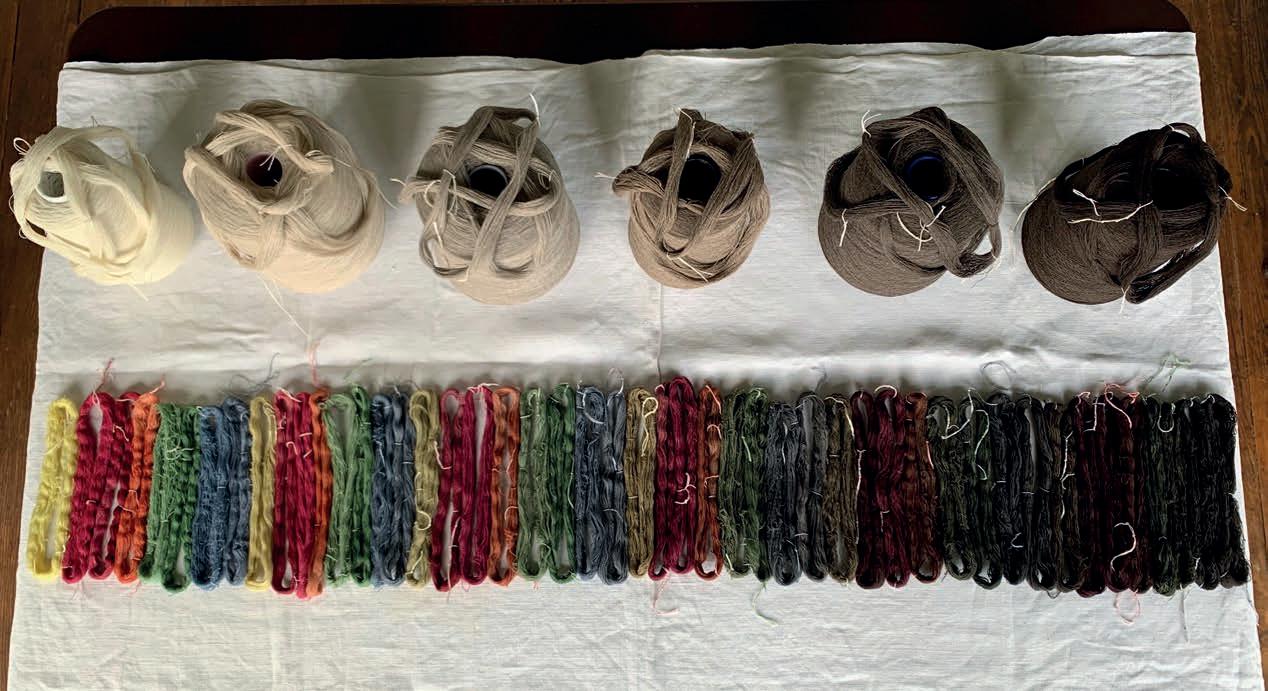
issue034 textures 78 www.pancolori.eu COLOURS
11. Filato di cachemire.
11. Cashmere yarn. 12
11
12. Filati di cachemire di diverse tonalità al naturale e sovratinte. 12. Cashmere yarns in various natural and overdyed shades.





































 writer Beatrice Guidi
writer Beatrice Guidi


































































































































